| Date |
Title-info |
Description
or image |
Images |
2025
Aug
12
2300BST
Perseid Shower
|
A
14mm focal length lens on Canon 70D mounted on a tripod. 15sec
images taken over a 2 hr period from Steeple Aston. OXON
The
camera is pointing in the direction of Polaris. The radient
in Perseus is revealed when three meteor trails are traced
backwards to their origin.
Taken
in conditions of high-thin-cloud and Moon-light.
|
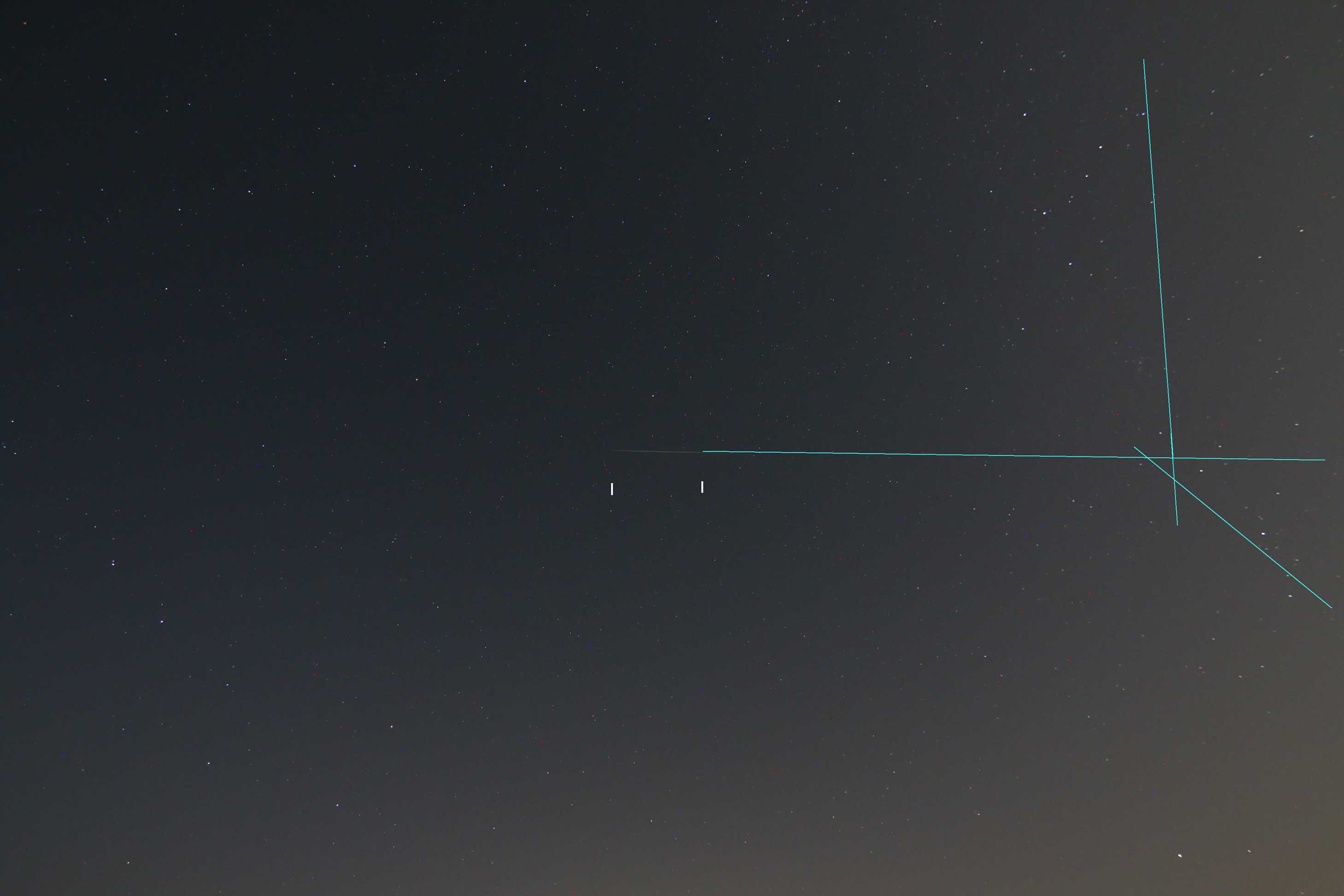
|
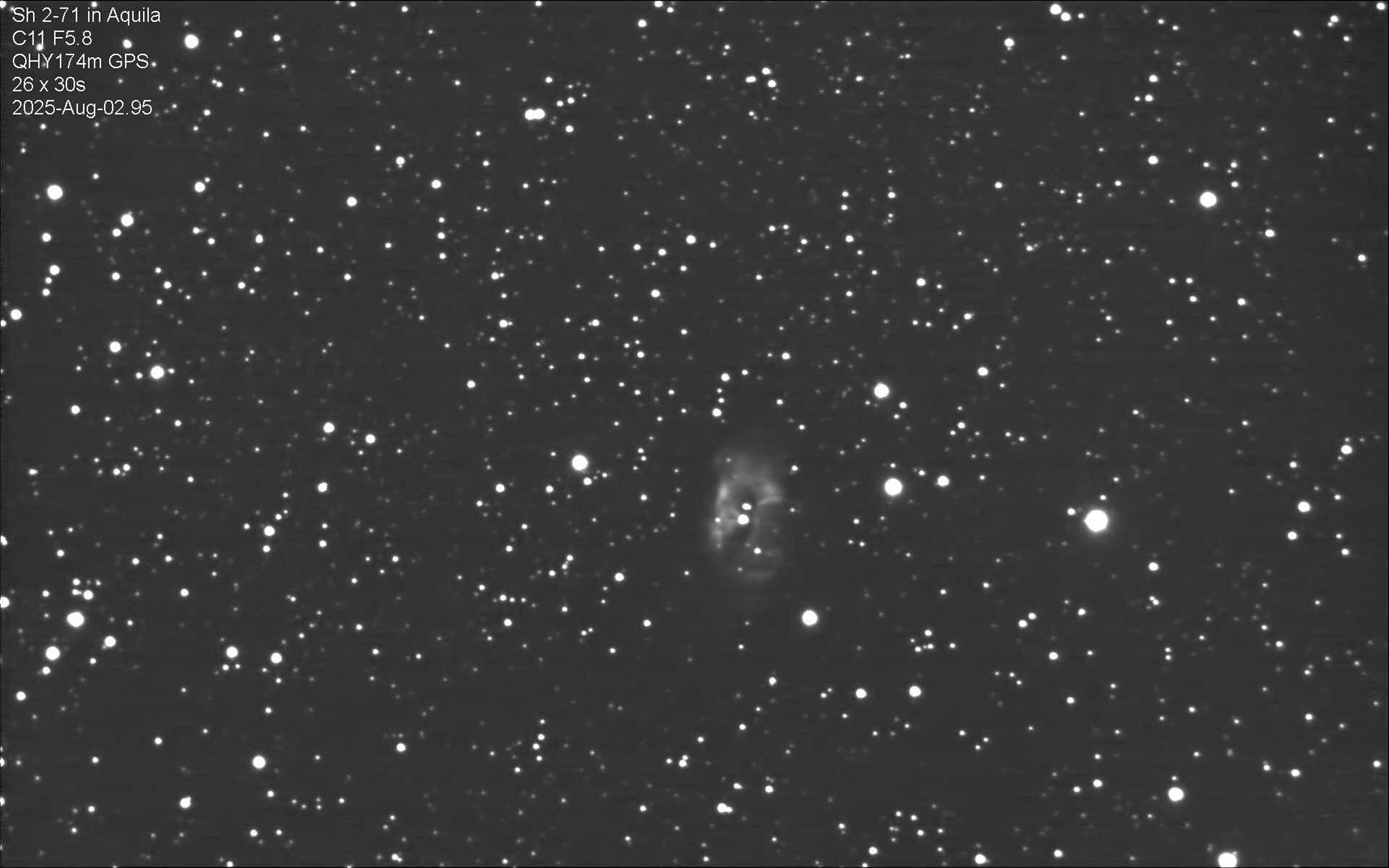 A planetaty nebula in Aquila Sh 2-71.
Camera and telescope combination taken on August 2nd. Twentysix
subframes of 30s each are combined.
A planetaty nebula in Aquila Sh 2-71.
Camera and telescope combination taken on August 2nd. Twentysix
subframes of 30s each are combined.
|
2025
March
29
10am
|
Partial
solar eclipse with a Canon 400mm lens and Baader AstroSolar
Safety Film covering the lens hood
Exposure
1/1000 at F/8 , iso100
|
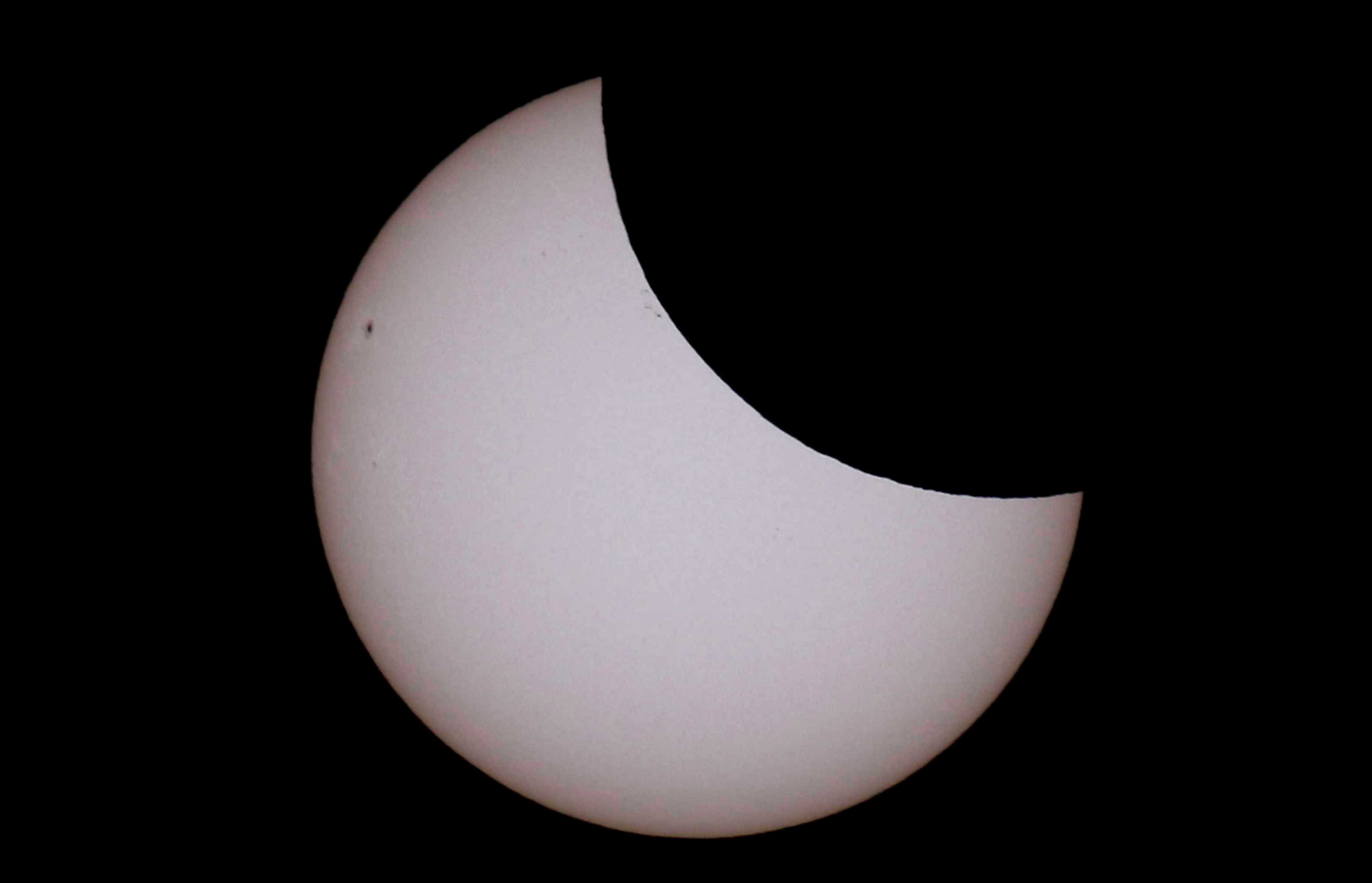
|

New Moon the following
evening March 30
|
2023
April
23
2115bst
|
Photos
of a Blueish Aurora from South Side, Steeple Aston looking
North, and earlier in the evening a view of the crescent Moon
attended by Venus
|
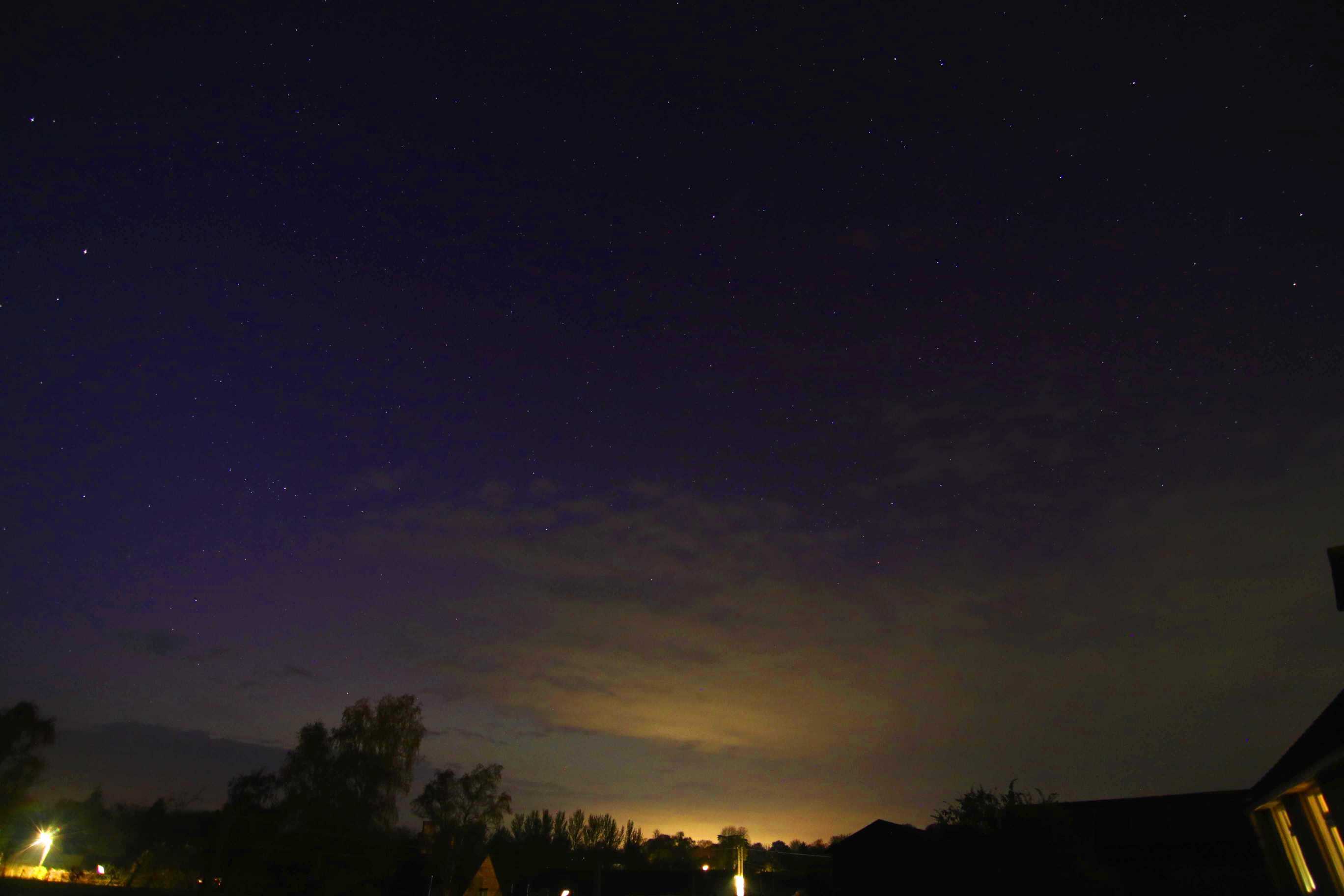
|
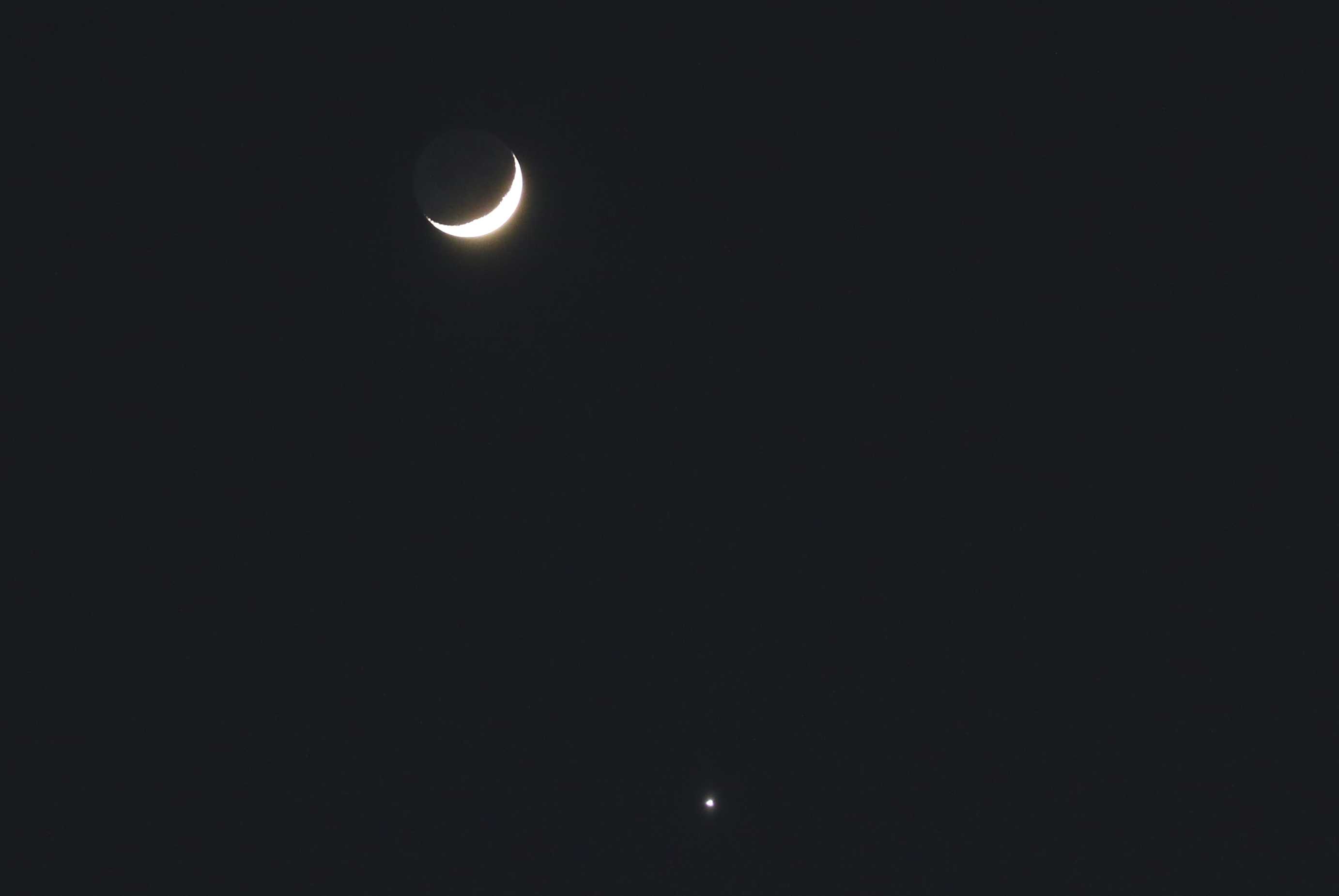 Moon and Venus
Moon and Venus
on 2023 Apri 23,
2017 BST
|
2023
March 23/24
|
Photos
of the Aurora from South Side, Steeple Aston looking North.
11mm len sat F3.5,
13 sec at iso 1600
|
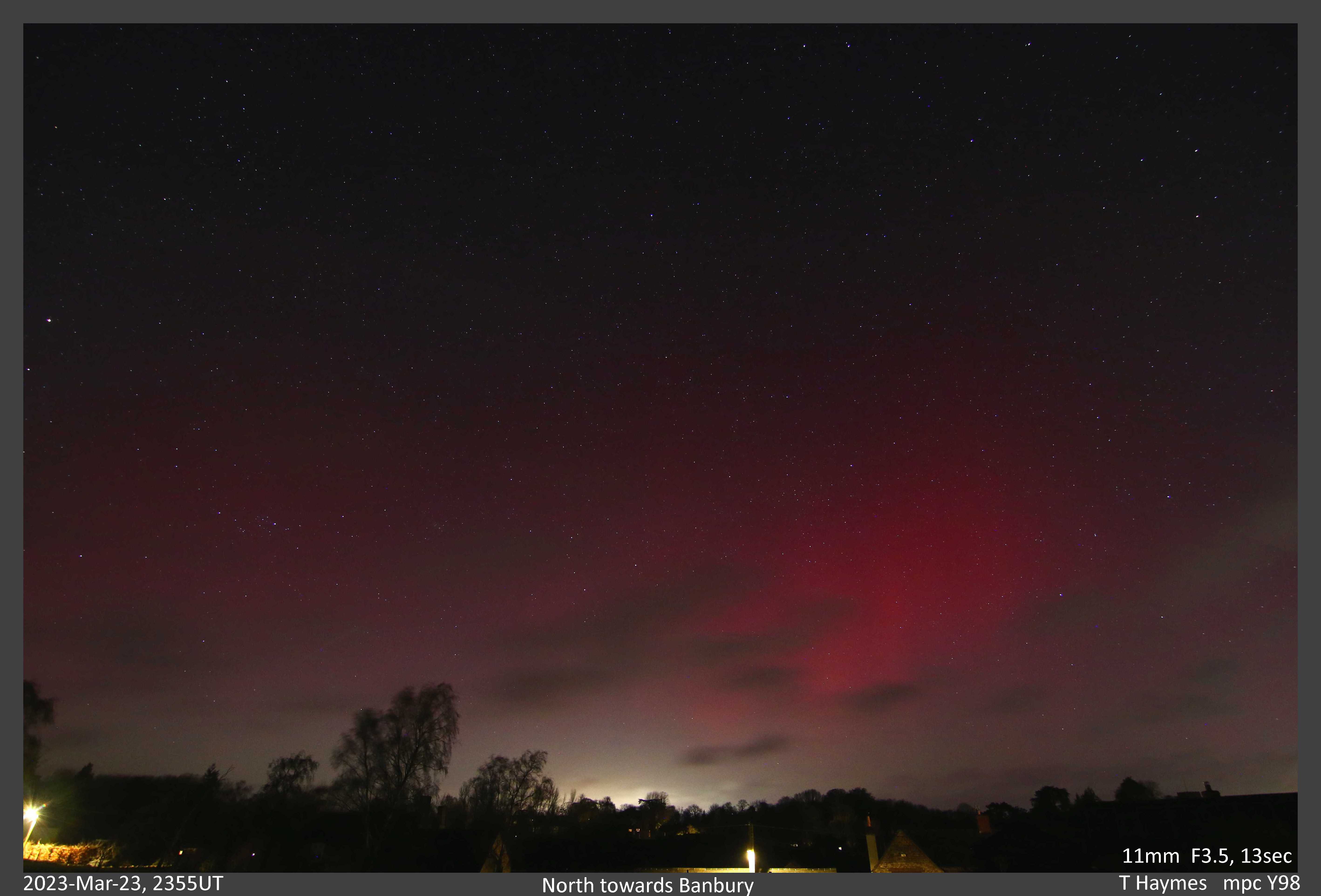
|
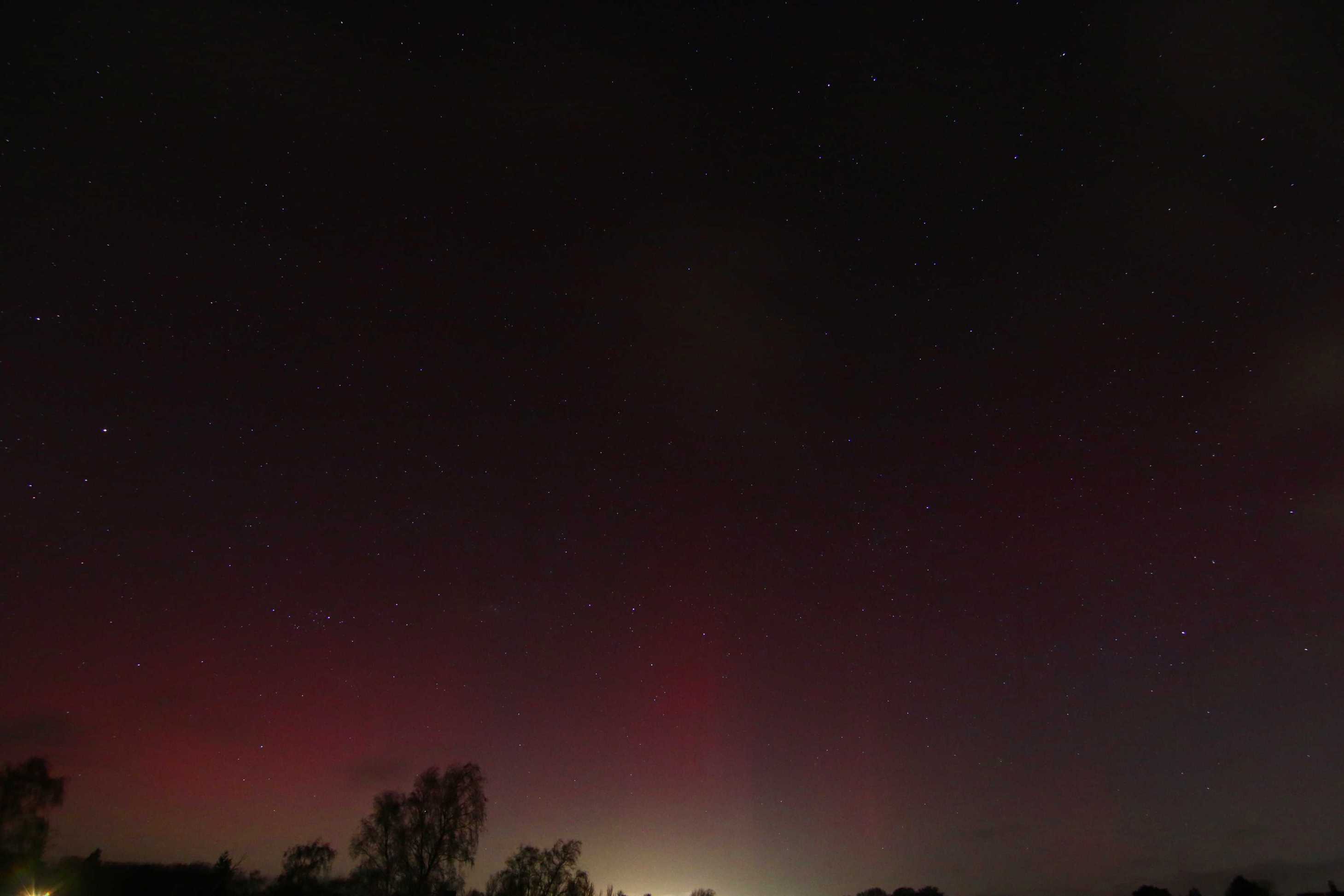
Taken at about 0030 hrs
Some structure is begining to show in the clearer sky line.
|
2023
March 23/24
|
An Aurora was forcaste.
It was seen on the camera screen as a red glow.
|
I use the alert monitor on this web page linked to Universiy
of Lancaster. At 11.30 pm the alert status was red ( Red-Alert
!). I rushed outside with camera and tripod and observed the
red flow mixed with cloud in the sky above Banbury (which is
9mile north of me). Over the next 2 hrs the glow weakened but
extended to overhead. At no time was i able to see the colour
by eye or even suspect an aurora was in progress !
|
|
2023
January
|
The
"green" comet C/2022 E3 (ZTF) just reached naked
eye visibility in a dark sky, becoming circumpolar.
Its
changing tail detail was noticable in images taken by astrophotographers.
|
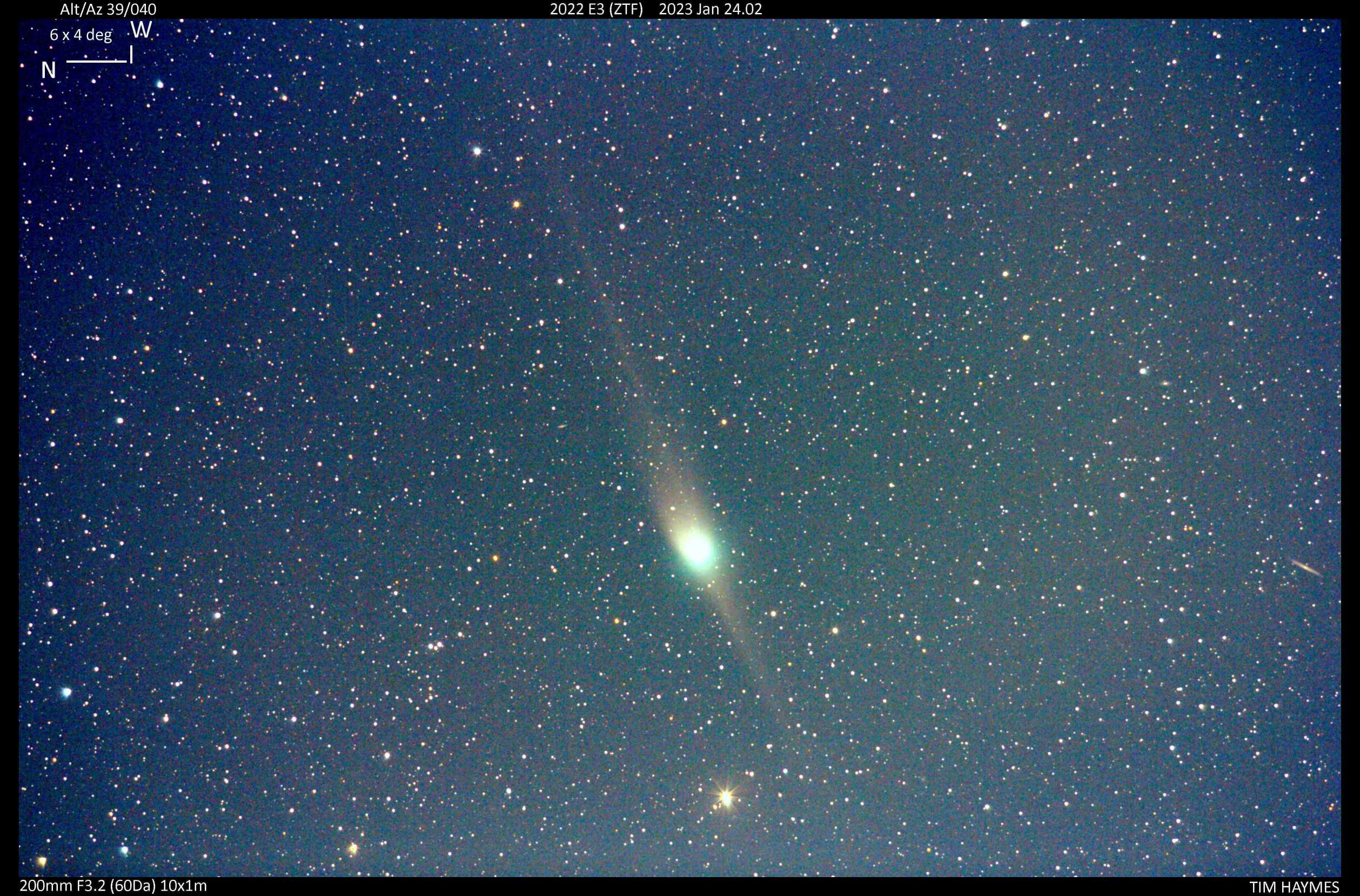
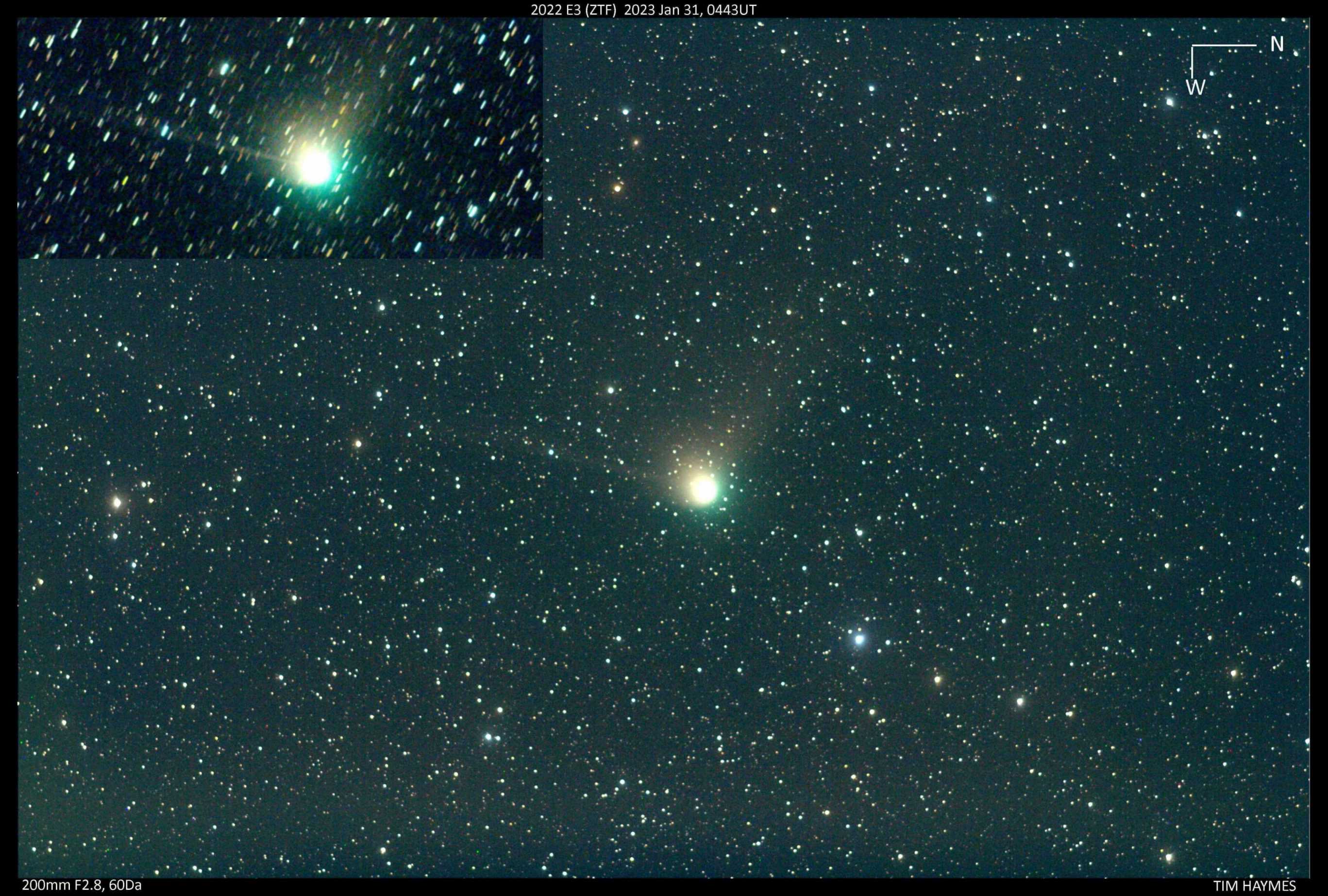
Anti-tail in the plain of the orbit, and rapid movement when
only 0.3 AU away.
DSLR 200mm F2.8 lens. 10x60sec stacked as RAW and processed.
|
|
2022
Apri 20th
|
Solar activity
in the form of
sunpots
|
Several nice spot groups comings over the West limb of the
Sun.
The image was taken through a Lunt Herschel Wedge attached
to a SkyWatcher 80mm F5 short-tube refractor. The wedge removes
the harmful infrared radition (heat). The light is then filtered
with a 10nm continuum filter (green) to improve contrast, and
imaged with an Image Source USB video camera. Old technology
by current standards, but it works. Alternatively a full apeture
solar filter could be used in place of the wedge.
Technical details: Camera with MagniMax barlow (x1.6) exposure
1/500th at 30 frames/sec, low gain and 500 frames taken as AVI
using image stacked software, then sharpened in RegiStax5. Final
image is here.
|
|
2021
Oct 17th
|
Lunar
Halo
in mist
and
high
cloud.
|
We dont see halos partcularly often. I saw the ice ring
when i stepped outside to check on the sky conditions. The Moon
was full and bright at 11pm and due South when i took the shot.
Refraction of light through hexagonal ice crystals is thought
to produce the phenomenon leading to a ring 22 degress in diameter.
In instances of stronger refraction the halo can be coloured
like a rainbow. I couldnt see any colour this time. Photo taken
with a wide angle lens focal length 11mm
|
|
2021
Oct 16th
|
.
|
The title is not a London postcode
(SW1). The object is the 29th Comet confirmed after (1P)Halley.
Discovered by Schwassmann and Wachmann (to give the name in
full) in 1927. It recently underwent a large outburst when cryogenic
gasses errupted. The reason so far is not clear, but its the
largest erruption seen for 40 years. Its still not bright enough
to see with the the naked eye because it has no tail. P = periodic
i.e. it orbits the Sun. 29P is unusall because theorbit is between
Jupiter and Neptune and roughly circular.
|
|
2021
July 14
|
ExoPlanet
Transit
HAT-P-23b
.
|
An Exoplanet transit was successfully recorded (Third attempt).
HAT-P-23b was measured from 2300 to 0230 BST on the night of
July 14/15. A QHY174m-gps CMOS camera was used on my 30cm F/4
Newtonian and 105 exposures of 20sec at 2 min intervals were
analysed by HOPS Ver3 (Anaconda). During the sequence controlled
by SharpCap
software, the image position was nudged to keep in centre. For
best data the stars were defocused slightly
|
|
2021
Jun 10th
|
.
|
We don't often get a partial solar eclipse visible from
the UK, and when we do its often clouded out ! The June 10th
eclipse was seen
through cloud cover with dark glasses. Some cloud shots were
also taken with DSLR and Tele lens, but this image was taken
through a small 3" refracting telescope fitted with Lunt
Herschel wedge and continuum filter (Narrow band, in the green).
The wedge removes all the harmful heat (IR). There is an internal
filter but this is supplemented with the dense green filter.
I held a mobile phone at the eyepiece. I took a load of shots.
Most were no good but this is a better one. Its in focus.
|
|
2021
April
|
The
new
observatory
|
This Pulsar 2.7m observatory has been in use for several
months now. It was a long awaited installation that was ordered
before the COVID-19 pandemic. Repeated lock downs interrupted
its fabrication and installation. The main problem was finding
a builder to make the base for it. This was laid in Feb. 2021.
The dome is motorised. Its a beautifully Sage green. After 14
months from order, the guys at Pulsar Observatories installed
the dome.
I'm keeping a diary describing a few problems that have occurred
since and how they were fixed. This includes telescope use and
some improvements.
You can read my diary here.
|
|
2021 Feb. 3rd
|
gamma
Leo is
a double star
.
|
I used this binary star to test the telescope and camera
in a project with another observer. The two components are separated
by 4.7 seconds of arc. This is quite wide and easy for this
telescope to resolve. Its usually atmospheric turbulence that
limits the ability of a telescope to see very fine detail (or
the eye to behold it). Now we have software to improve the images.
The resolving power of my 11" aperture telescope is 0.4"
(Dawes Limit) but this is rarely achievable. I should be able
to resolve two stars with 1/4 this separation. We will see.
|
|
2020 Dec 19th
Evening
|
|
The Winter constellation of Orion is a well known "landmark"
on the celestial sphere. With a suitable filter and camera,
the glowing hydrogen gas over the whole area can be recorded
as red patches. To the eye only the more familiar Orion Nebula
can be seen which is the bright pink blot near the bottom of
the image. The arc structure is part of "Barnards Loop".
Details: Canon 60Da, Astronomik CLS clip filter, 35mm F2 lens
with 30sec exposure. Nine exposures added in software.
|
|
2020 Dec 20th
Evening
|
|
The much awaited "Once-in-800-year" "Christmas"
conjunction was photographed on thr 20th. Cloud spoiled the
best view on the 21st. Still a very nice alignment between clouds.
You can see Jupiter (below and brighter) together with Saturn
above - as seen from Steeple Aston
DSLR and 50mm standard lens on a tripod with 6sec exposure
|
|
2020 Nov 6th
2358UT
|
Lunar Graze Occultation
of
SAO 79806
[Video is used to time lunar limb contacts
as the star passed behind the Moon's edge. 12 contacts were
recorded in agreement with prediction ]
|
I was lucky with the weather again. The Moon was in cloud
when i set off but cleared a few minutes before the graze commenced.
This was the third prediction (second this year) observed from
the South Leigh area, Oxfordshire. https://youtu.be/50Dh-TJXlYc
The location was selected to give the best results. Analysis
shows good agreement between observation and expected shape
 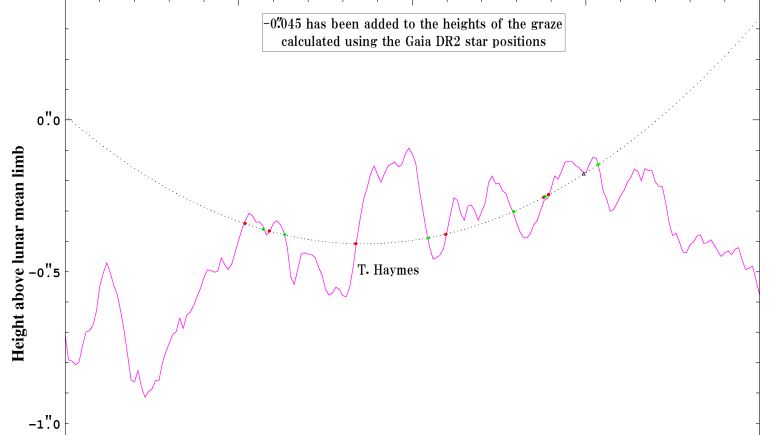
Prediction software and the Observation reduced by IOTA-Japan
|
|
2020 Sept 13th |
|
The furthest object seen by the naked eye, is 2.5 million
light years distant and approaching us at 300 km /sec. At 1
trillion suns, it is more massive than the Milky Way (abt twice).
This image was taken through a small telescope with 5min exposure.
The colour difference (centre vs edge) is caused by age differences
of the stars. Younger stars are blue and populate the spiral
arms. Dark streaks are caused by cold dust clouds that will
eventually form new stars. |
|
2020 Sept 11/12th |
|
Two videos was taken with a Celestron 11 and 2.5x Powermate.
About 1000 good frames were stacked (lucky imaging) and contrast
enhanced with Registax5 and Photoshop CS2. The LHS image is inverted
with South Polar cap as at the top. Here is an animated
view from a longer series of stacked frames. RH image some
days earlier. |
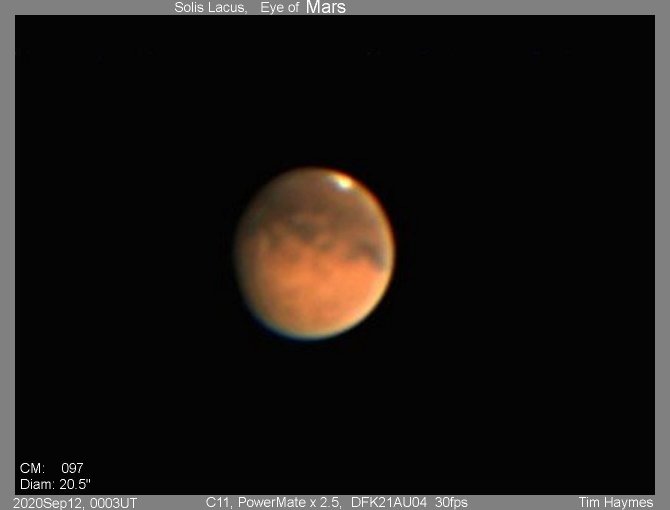
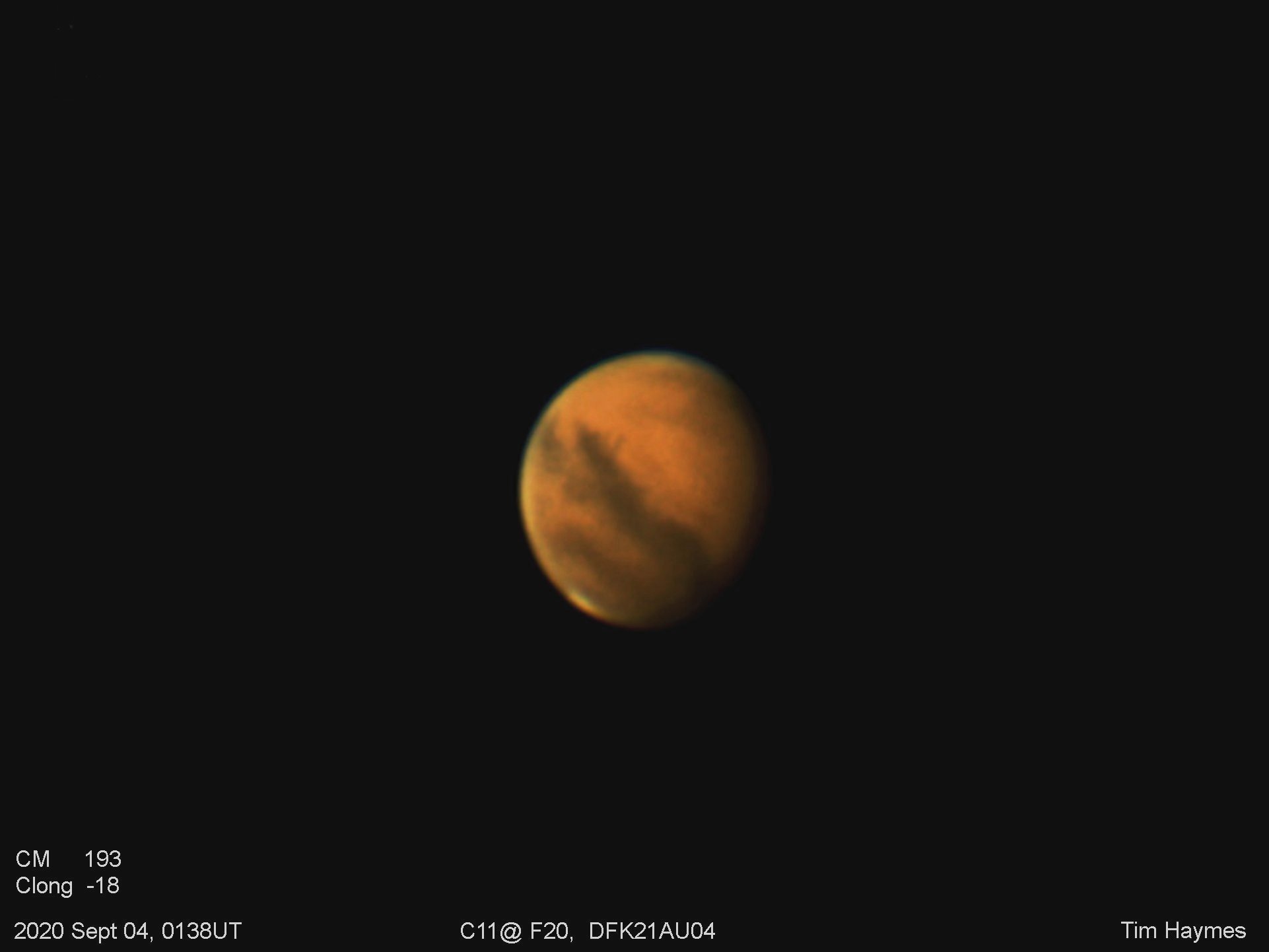
|
2020 Jul 10-20th |
C/2020 F3 (Neowise)
Comet images from Steeple Aston
|
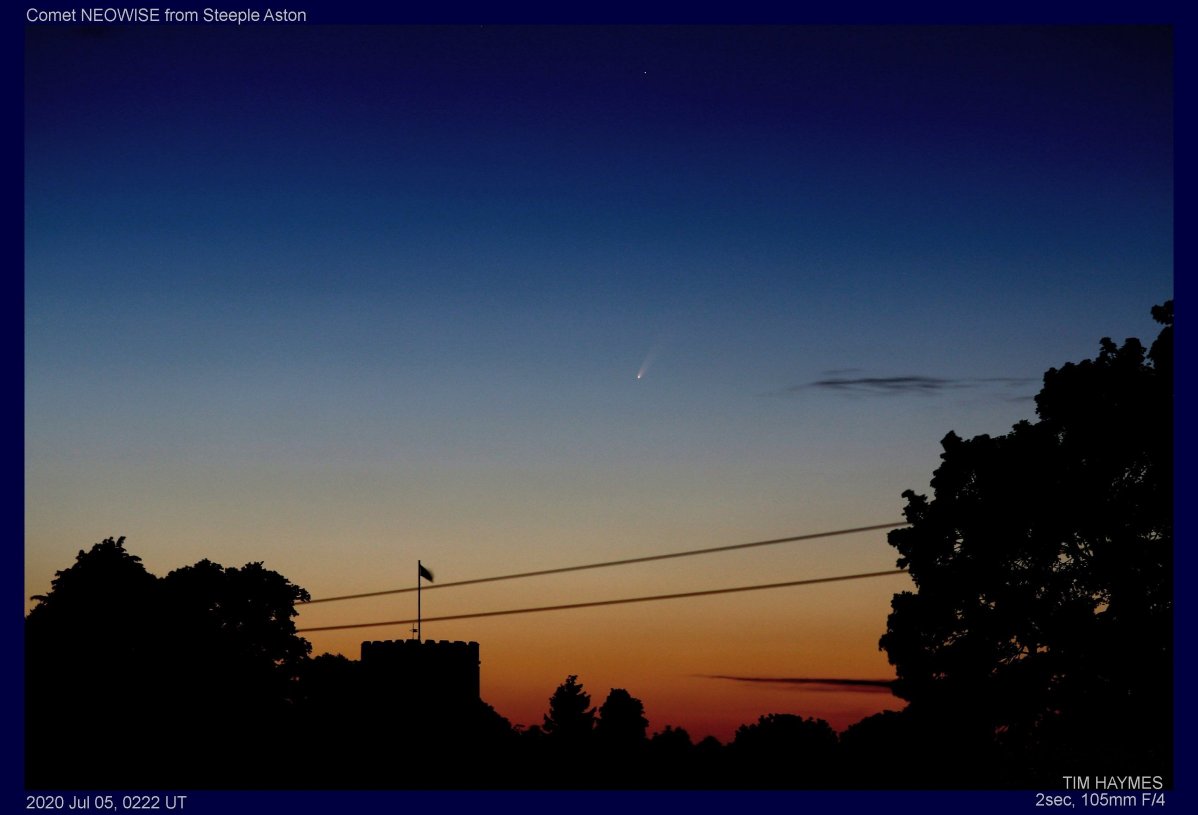 ....
.... 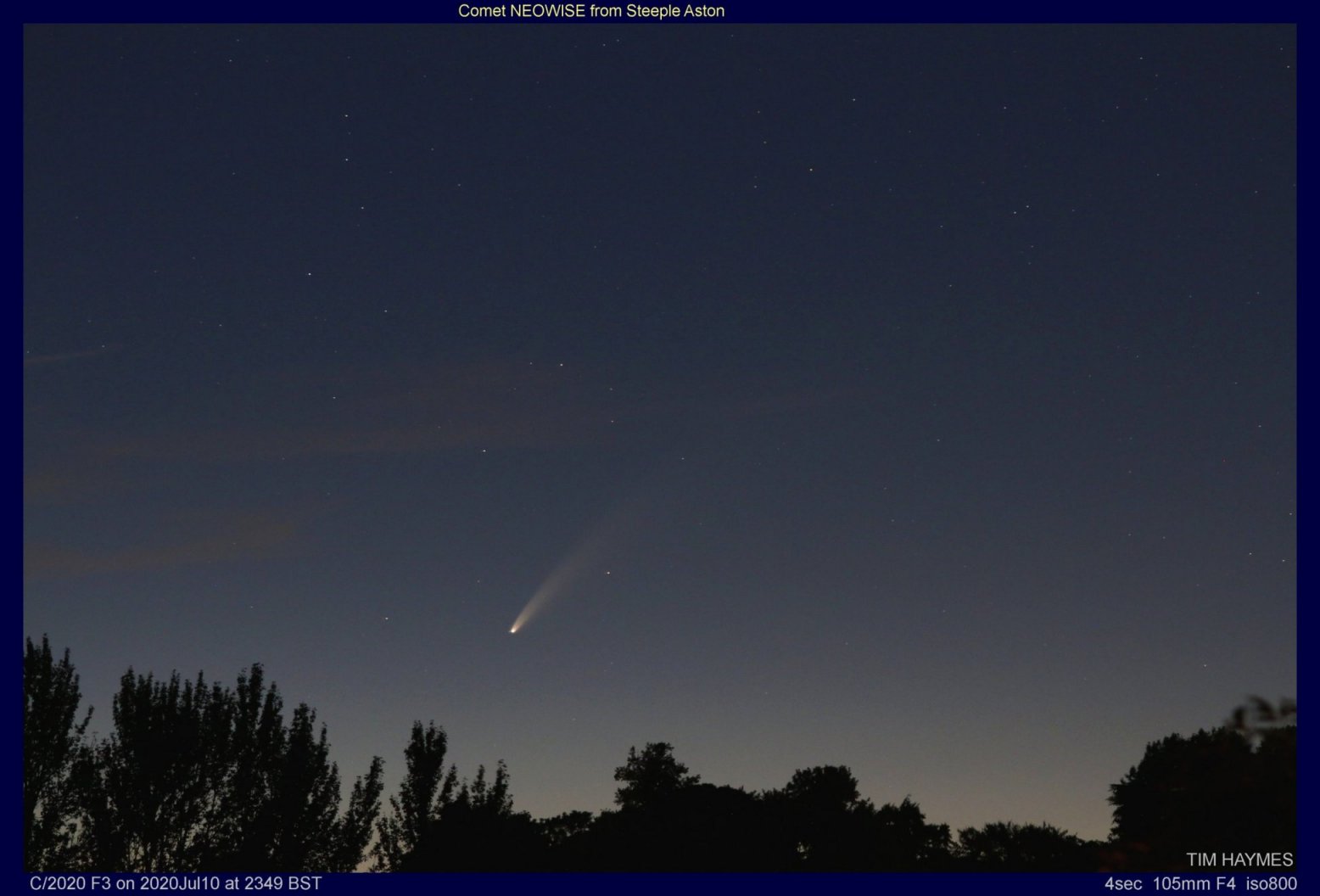 .... ....
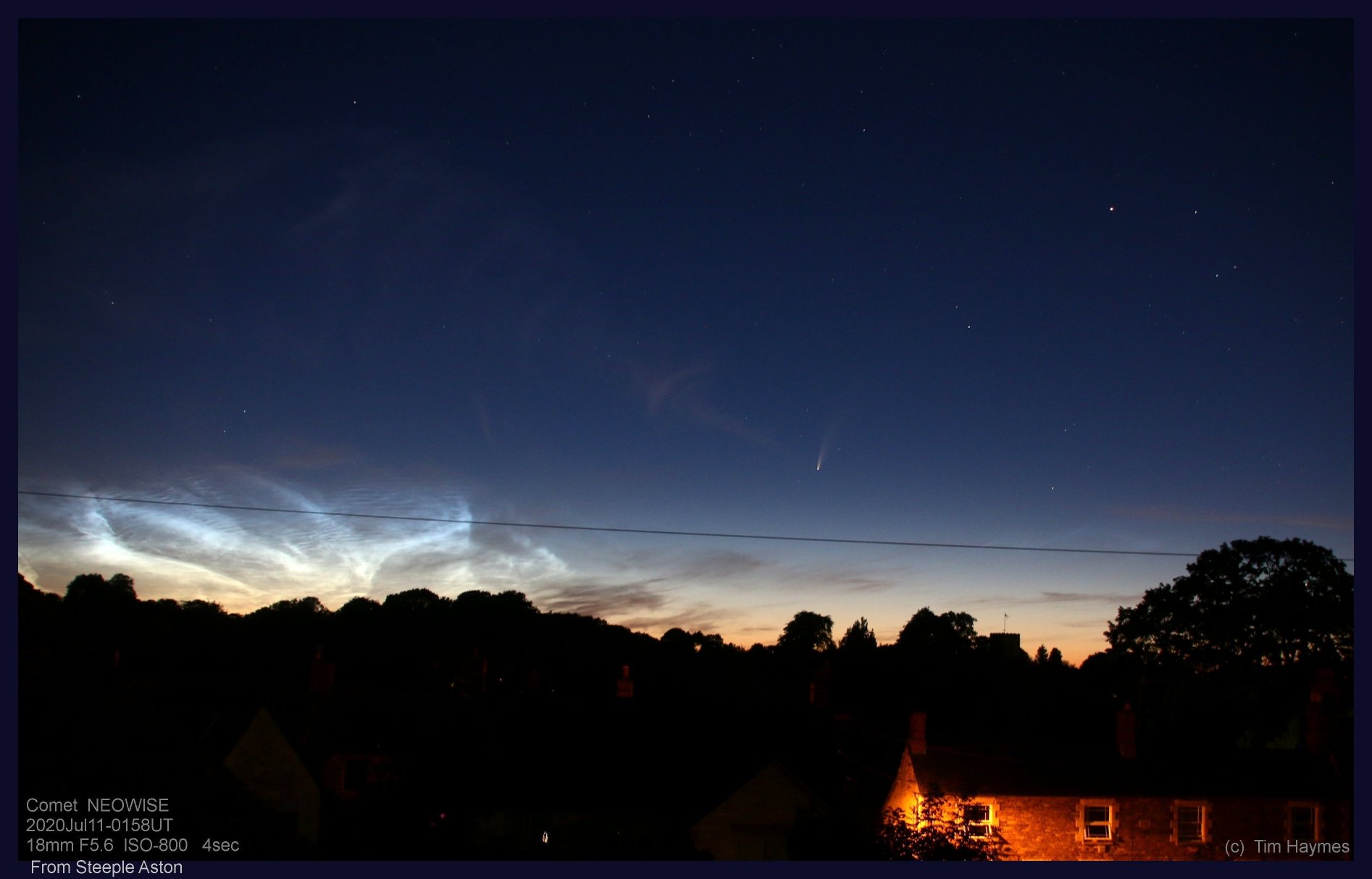
over the Church .........................now in the evening.....................with
Noctilucent cloud
|
|
2020 Jul 10th |
My First light curve
of an Exoplanet transit
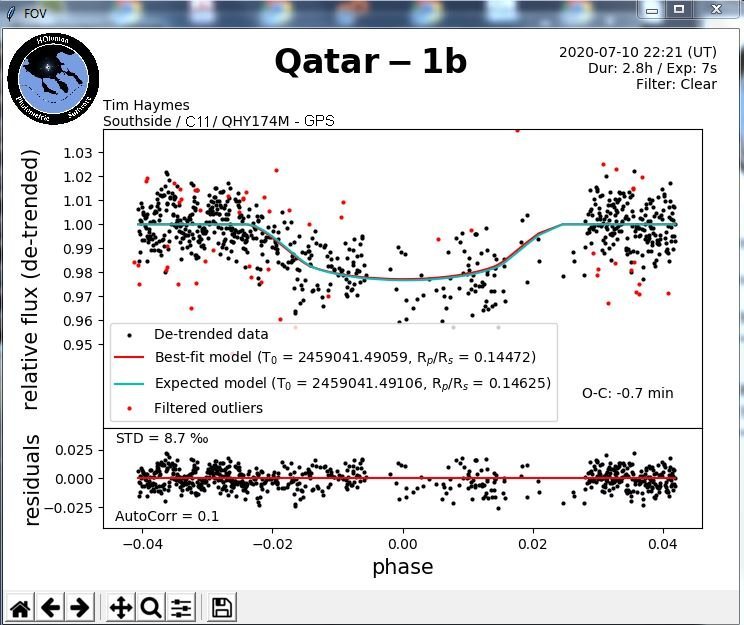
Qatar-1b
|
The Exoclock project web site provided an opportunity to
measure the exoplanet transit by Qatar-1b
of a 12th magnitude star high up in Draco. Sky conditions were
good and the whole transit was during darkness from ca 11pm
to 2am BST. I captured 1350 images at 7 sec intervals. There
were some problems with the image but these could be worked
around. The Light drop was 2.5%.
Instrument:: Celestron 11 at F5.5, QHY174m-GPS
camera. The light from the star
is diminished slightly when the Jupiter sized exoplanet passed
in front. The transit method is used to support professional
researchers interested in the evolution (orbital time) of these
remote planetary systems. An amateur astronomers can now do
this with help, and the right equipment.
|
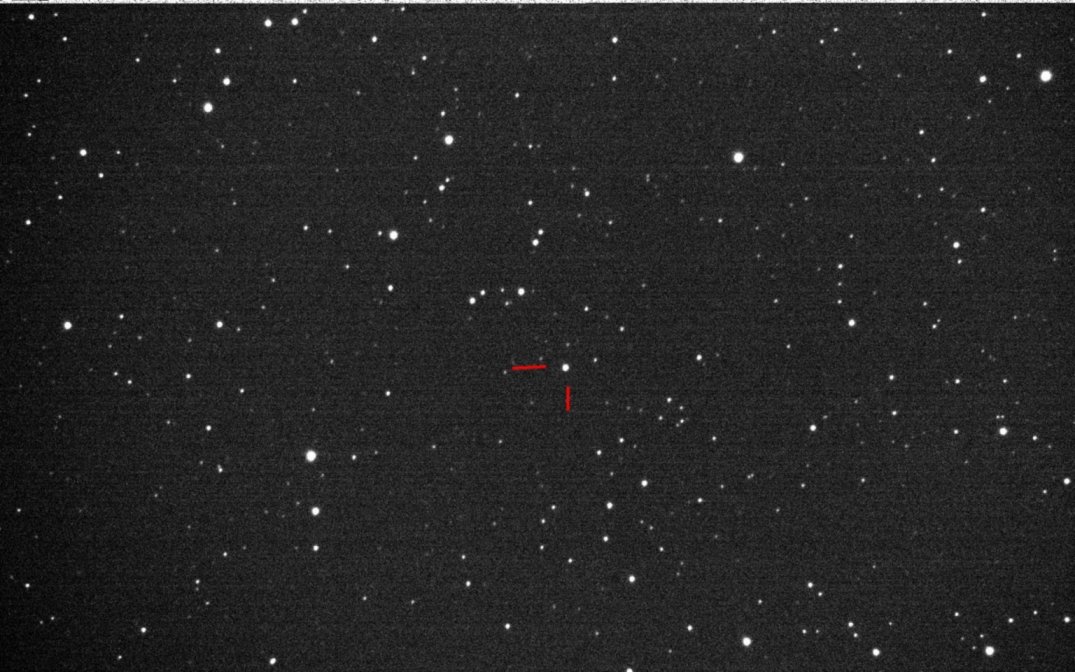
The star in question. |
2020 Feb. 5th |
Use of a Robotic Telescope
|
I was invited to create an account for the Telescope Live
network of robotic
instruments. Some free credits are given to new subscribers.
I used some of these to image interesting galaxies. Here is
one of Centaurus A (Southern hemisphere), which is a radio emitter
now known to be a very active galaxy with large amounts of dust
- as can be seen in the image. This was taken through the CHI-1
instrument in a single 2min exposure.
|
|
2019 Dec 29 and 30th |
Moon and Venus, and comet Panstarrs
|
Got a cracking view of the crescent Moon near Venus this
evening, looking SW. Then on the 30th it was clear for long
enough to obtain 25 exposures of 40s each of comet PanSTARRS
2017T2. These are stacked to give a clear image with a short
tail about 0.1 deg long.
|
|
2020 January |
|
Not a particularly good start to the year, but I have imaged
Comet 2017 T2 a few times (not very bright) and recorded three
negative asteroid occultations out of 27 events that were clouded
out. I was able to test a new camera, the QHY174m-GPS. Here
is one of the first images of a negative asteroidal event using
my Celestron-11. The target star is indicated and the sky was
hazy.
|
|
2019 Nov 29 |
Celestron 11 XLT
2nd Occultation +ve
|
The focal reducer works at F/3.5 to F/4, and an occultation
by asteroid (105) Artemis was recorded this evening. I also
took some images of comet 2017T2 and found the object quite
faint at mag 9.5, There is a short tail in the image of about
0.1 degrees. It's expected to be brighter in Spring 2020.
|
|
2019 Nov 21 |
|
An ADM Losmandy D-series saddle plate arrived (made in the
US) via First Light Optics, so I can now mount a C11 on my EQ6.
With the dew shield, the balance point needs 3 x 5 kg counter
weights. Good job a bought a spare a couple of years ago. I
have now measured the spacings for the focal reducer and hope
to test the telescope on stars. I have also drilled two holes
in the Celestron finder bracket so that I can use my SkyWatcher
finder. |
|
2019 Nov 10 |
Celestron 11 XLT
SCT f/10 Fastar.
|
I collected a used F/10 C11 XLT today for £1150. This
included a dew shield, F6.3 focal reducer and eyepieces. Weight
of the OTA is 12.5 Kg. The instrument has had some use over
the years (10 may be) based on the paint scratches. Optics look
clean. C11s are reputed to be good, but I've not got it mounted
yet. It is FASTAR compatible for imaging a F/2. |
2024: C11 working well at F5.8.
Moisture internal needs drying out in winter months (Silica
Gel). Slight mirror flop but that is expected in the XLT ! |
2019 Nov 07
|
First POSITIVE
asteroid occultation from SA
|
This evening was clear with a Gibbous Moon to the S/SW. An
unexpected lack of serious cloud prompted some occultation observing.
(563) Suleika occulted UCAC4 553-028752 (second of three predictions)
and a very small flux drop of 0.1 magnitudes was expected. The
video is noisy and awaiting further analysis before the report
is completed. See the light curve ==>
I recorded three events in 3 hrs, and got to bed at 2.45 AM.
Temp was +2 C
|
|
2019
Oct 26
|
Dark sky photos from Steeple Aston
(SA)
|
There were a couple of clear Moonless evenings, so took some
snaps of the sky. Here we have the Milky Way and the horizon
South West. Camera on a tripod at high iso,exposure 10 to 20sec.
They were stretched bit to bring out some detail.
|
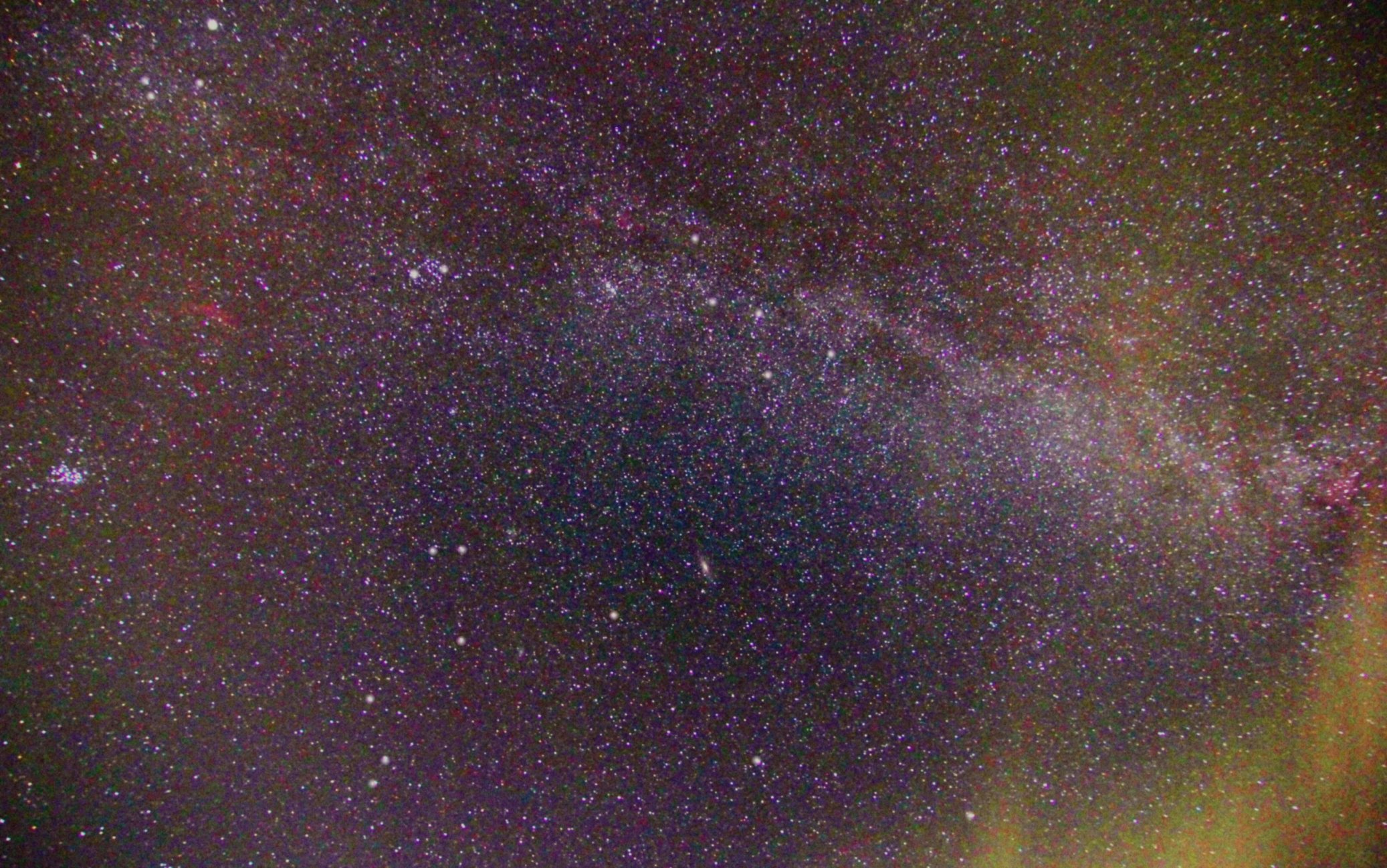 . 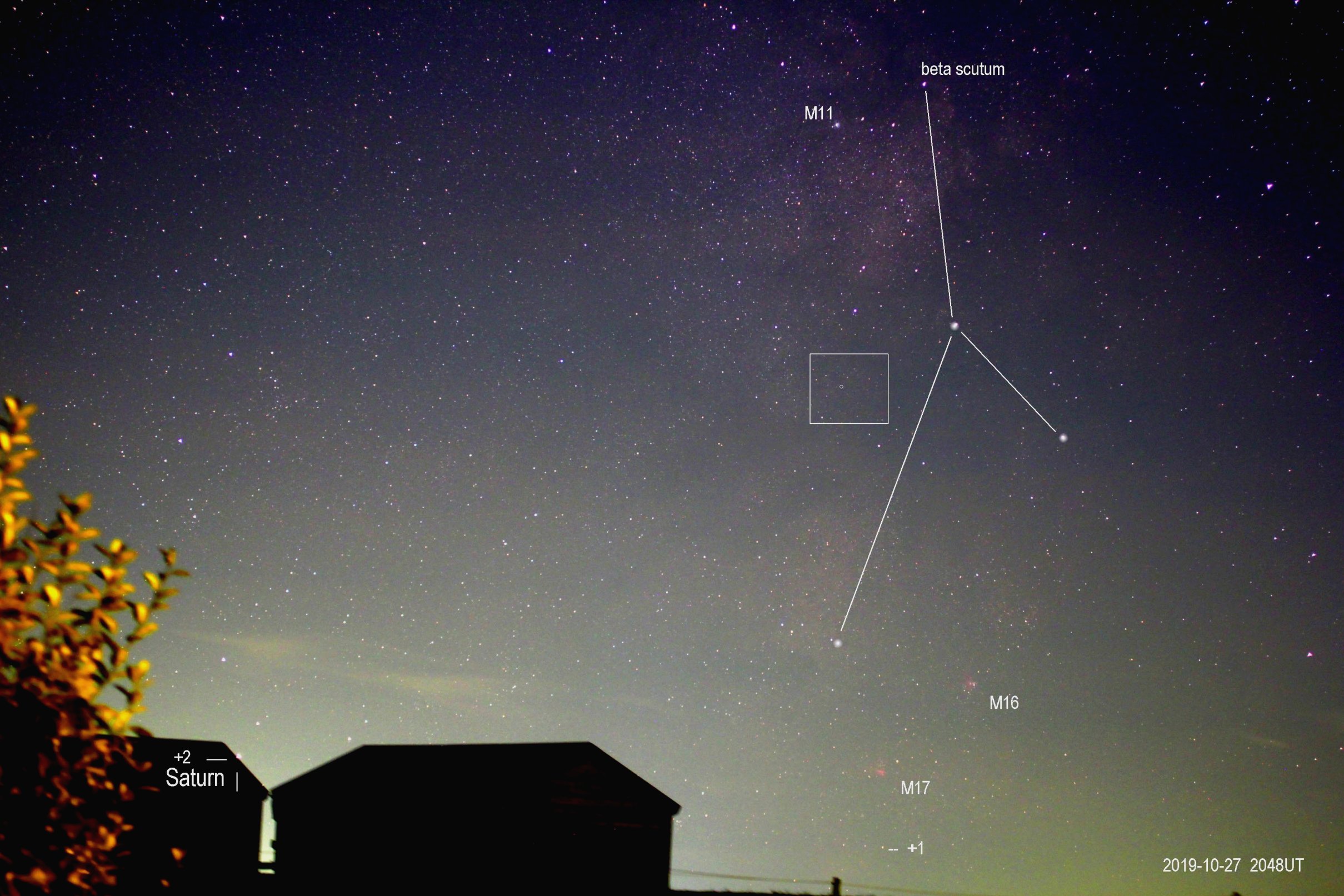
|
2019 Oct 9th, 2240UT
|
First report from Steeple Aston, Oxfordshire:
asteroid (1476) Cox
|
Trimmed the polar alignment and tested the goto functions
of the mount. Found the 11th mag star in Taurus a few degrees
north of the Pleiades. Moon (86%) was in the South but this
wasn't problem since the sky was clear (not forecasted though).
The star was recorded by video at 25 fps, but there was no occultation.
Two other observers (Maidenhead and Reading) also report no
event. |
Cox%20Occult.JPG)
Predicted path of the asteroid shadow |
2019 Oct 8th, 2300UT
|
Observing from Steeple Aston,
Oxfordshire.
|
We are gradually moving in and making a new home for ourselves.
The location promises a much darker sky, but this night we set
up to observe a Jupiter Trojan (1583)
Antilochus occult a 12th mag star in Pegasus. The EQ6
mount was polar aligned and connected to the laptop, but cloud
moved in and no observation was possible. At least it was all
working OK. [Trojan asteroids orbit ahead and behind
Jupiter by about 1/6 of an orbit (60 degrees)
|
No Image |
2019 Aug 27th
0415 UT
|
Lunar Graze of delta Geminorum
BAAH #11 ZC 1110
16 km W of Warwick
|
A Northern limit prediction (CA 10N) for this bright 3.5
mag star offered 12 contacts at a crescent phase. Conditions
were perfect with Earthshine and a little ground mist. It was
an early start for me at 2.30BST, arriving at the site by 4
am to leave an hour to set up. I had planned to observer near
a farmer's gate, but when I arrived the gate was open, so I
set up at the edge of field. (Red X)
001 49' 8.4" W, 52 17' 26.7"N and away from the road.
|
|
2019 May 9th
|
Lunar Graze at Fishguard
BAAH #9 SAO79410
|
The Northern limit prediction at CA 1 deg offered 4 to 6
contact. From the camp-site the evening started clear. The lunar
limb was Earth lit and the star obvious at magnitude 7.2. Video
was set to 25fps. Graze contacts were expected to be recorded
with ease despite the proximity of the 26% ill cusp. The OTA
was 20cm F/4 with 2x Barlow. Cloud began to encroach from below
and the recording was spoiled. One D event was seen, and a second
obtained when the video was stretched in Virtual Dub. The report
was reduced by Mitsuru Soma. See diagrams >>>
|
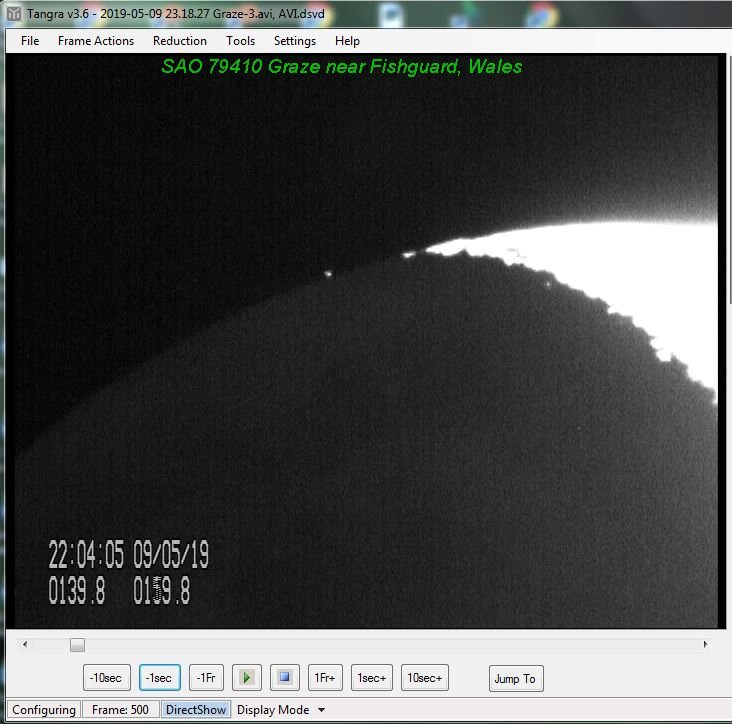
..  |
2019 April
|
|
A good number of Lunars have been timed in Taurus, Gemini
and Cancer (M44) using the 8" and video [ 48 in total ].
I have uploaded the M44 sequence here: https://youtu.be/bD-4hmdg1DI
The video is quite long, and has a variey of occultation event
to see.
|
|
2019 January
|
New temporary (rented) location at
Florence Villas, Bottle Lane, Littlewick Green.
|
Horizon is improved in the South. The mounting is now drift
aligned on the pole, and I can operate with the laptop in a
garden shed via a 3m USB cable. Dew formation is now a problem
with the 20cm Schmidt Newtonian in winter. I am limited to about
1.5 hrs, which is just enough time to mount the OTA and finder,
make electrical connections, sync on a field star and make the
observation by video or do some imaging. I have ordered a heated
dewshield to replace the DIY cardboard one. |
|
2018 December
|
Knowl Hill Observatory decommissioned
and
"most observed asteroid occultations"
|
2018 broke my asteroid oberving record starting in 2010,
with the most reports in a single year of 70, with 8 positive
events. ALSO an end to observing at Knowl Hill Observatory.
The house and observatory was sold December 19th. The 30cm F4
is in storage and I will be using tthe EQ6Pro and 20cm at a
rented house nearby. |
|
2018 Sept 23
|
(2875)Largerkvist:
A Strange occultation is observed.
|
A routine observation of low probability involving a 20Km
diameter asteroid.
1) The occultation was not a full disappearance, but a 0.4 mag
drop. This was explained by the asteroid occulting an "unseen"
companion of a multiple system.
2) There is an unexplained difference in two observations that
suggest a multiple star was involved.
I measured a rotation light curve (0.5 rev,) and comapared it
to a publish curve. They are similar. More observations of the
asteroid would be nice. There is a page on this website with
more detail. The light curve was
from FITS images, measured with Astrometrica.
|
|
2018 Sept
03
|
Optical Transient near galaxy NGC2938
in Draco.
|
Probably a SN. At mag 16 in this image on 2018 Oct 03 from
2237 to 2242 UT ( 15 x 20s ) as FITS. ATIK 428ex (2x2bin). TEC
at -10C. Measured on a single frame with Astrometrica and UCAC4.
via TA early warning e-mail |
|
2018 Aug
13/14
|
Perseids, no Moon
2300 - 0045 BST
|
Again clear but after maximum. Forecast was for a sky clearing
which was correct ! Set up 70D and 11mm (remote) and 60Da with
35mm lens pointing at Ursa Minor (bulb). 11 shower members counted
and 5 images with meteors, although none were spectacular (mostly
mag 1 and 2). A good catch. The one image in the narrow field
camera had a greenish colouration
70D: 273 frames, 60Da: 194 frames |
|
2018 Aug
10/11
|
Perseids, no Moon
2330 - 0230 BST
|
Very clear with Milky Way appearing as a faint smudge (SQM-L
20.3). Set up the fixed camera on a tripod: Canon 70D and 11mm
lens (F2.8), iso 1600 and exposures between 15 and 20s with wireless
remote. In 350 images (3 hrs) I captured one. I did see one other
with a long train but was not on the camera. The following 2 nights
11/12 and 12/13 (Max) were clouded out. |
|
2018 May 7th |
JUPITER approaching opposition
|
At low declination and only visible around midnight UT (01h
BST). Never-the-less got a few AVIs and stacked them. Not the
best, but something. Is the GRS larger now? |
|
2018 May 5th |
(74) Galatea occulted a 12th mag star
in good conditions.
POSITIVE
|
Well, more good weather (3 days of 0% cloud) coinciding with
this favourable prediction. Many of the UKocc group got it, but
some folks were away (Bank Hol) or had technical difficulties
with their equipment. I recorder a 7.4 sec duration with 1 mag
drop, the second this year |
|
2018 May 2nd |
Bright Nova in Perseus
|
Reached mag 6, but had faded to 8 on the following nights when
I imaged it with a 105mm lens on the Canon 60Da. Strong red colour
caused by H-alpha. Best nova outburst since V1500 Cygni I would
say. |
|
2018 April 21st |
Wonderful (130) Elektra
POSITIVE occultation in good conditions
|
Weather forecast changes, but on the night it was clear over
England and much of Europe. I obtained a 16.4 sec disappearance
with the 30cm F/4 and WAT-910HX video camera. Lots of chords means
that my obs combines with 50 other results gives the best data
yet on this asteroid. See my asteroid page 2010-to present |
|
2018 April 14 - 2350h |
Hubble Deep Field
|
After weeks of rain and overcast conditions, I was enthused
at the BAA Winchester weekend meeting to have another "go"
at the HDF. The first attempt was deleted years ago, but the Sun
appeared on the 14th, and the sky was clear enough for imaging
in the evening. Although there was thin cloud (SQM 20.0, where
20.3 expected) the result from 25 min was quite acceptable for
this "grab and go" session (No auto guiding, no long
subs, short sequence ). The run was terminated by cloud after
27 min acquisition |
|
2018 Mar 13th |
Venus and
Mercury
|
The inner planets were presented this evening. The Moon appeared
in line two days later |
|
2018 Feb. 22 |
Observation Graph
|
The histogram was updated. No +ves yet in 2018. The Toni event
was clouded in Feb and this would have been a long event - just
unlucky. |
|
2018 Feb 12 |
SUN, First
light with Lunt Herschel wedge
AR2699
|
Intermittent Sun allowed me to take some Registacked images
with 120mm F/5 Helios, Image Source DMK21 and Baader solar continuum
filter 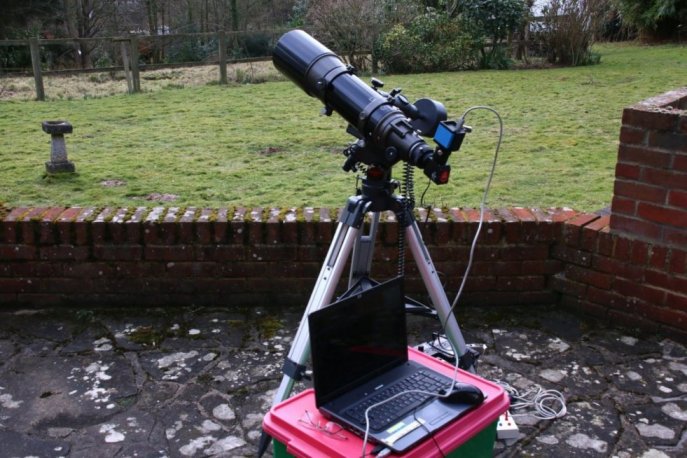 The EQ is LXD55
The EQ is LXD55 |
|
2017 Nov 25.0
Knowl Hill |
Bright Green
Bolide
|
A mag 8-10 (est) bolide lit up the ground at 0000hrs on the
24/25th at midnight. This was reported to the UKMON network
and BAA. Richard Fleet recorded it with his 8 camera station
at Wilcot (SW). I was outside observing occultation at the time.
There was no noticeable persistent train.
The brightest meteor I have seen since the great 1998 Leonid
fireball display.
|
|
2017 Nov 17
|
H-alpha imaging tonight
|
12nm, 200mm lens and ATIK camera. More on my Flicker Page |
|
| 2017 Oct 27 |
Comets
C/2017-01 asassn
C/2015-ER61 panstarrs
|
Imaged with an ATIK 428EX (2x2 bin) at -15C. Stacked with
DSS (FITS output) and tweaked with AstoArt5. Instrument: 30cm
F4 with Baader MPCC auto guided with SkyWatcher 80mm F5 and
PHD2. |
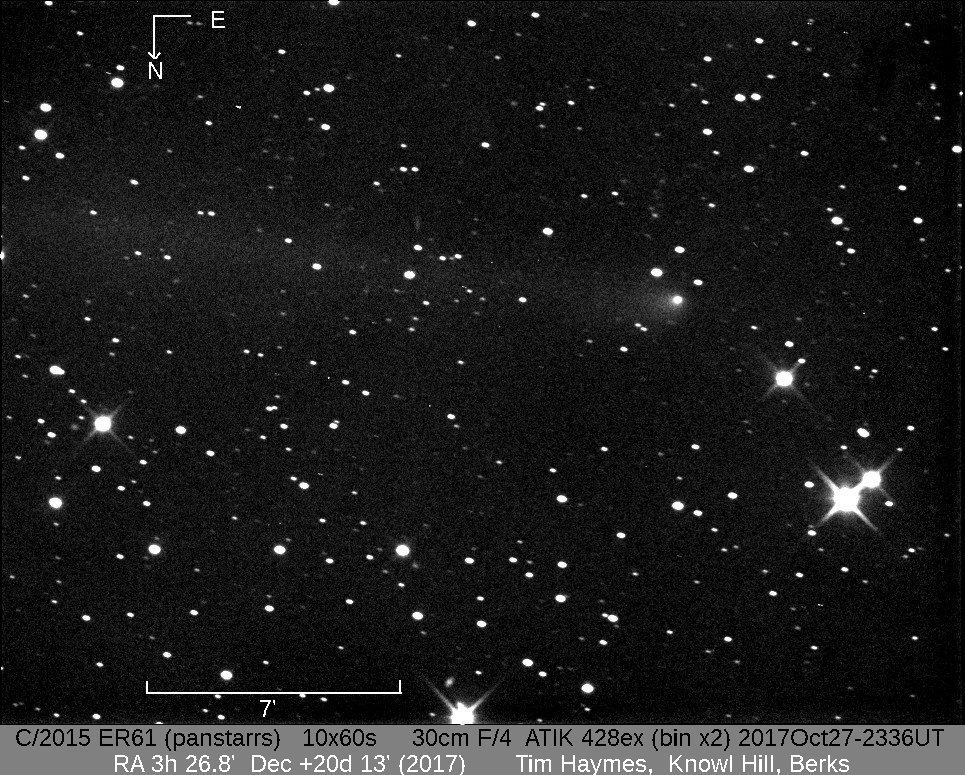 .. 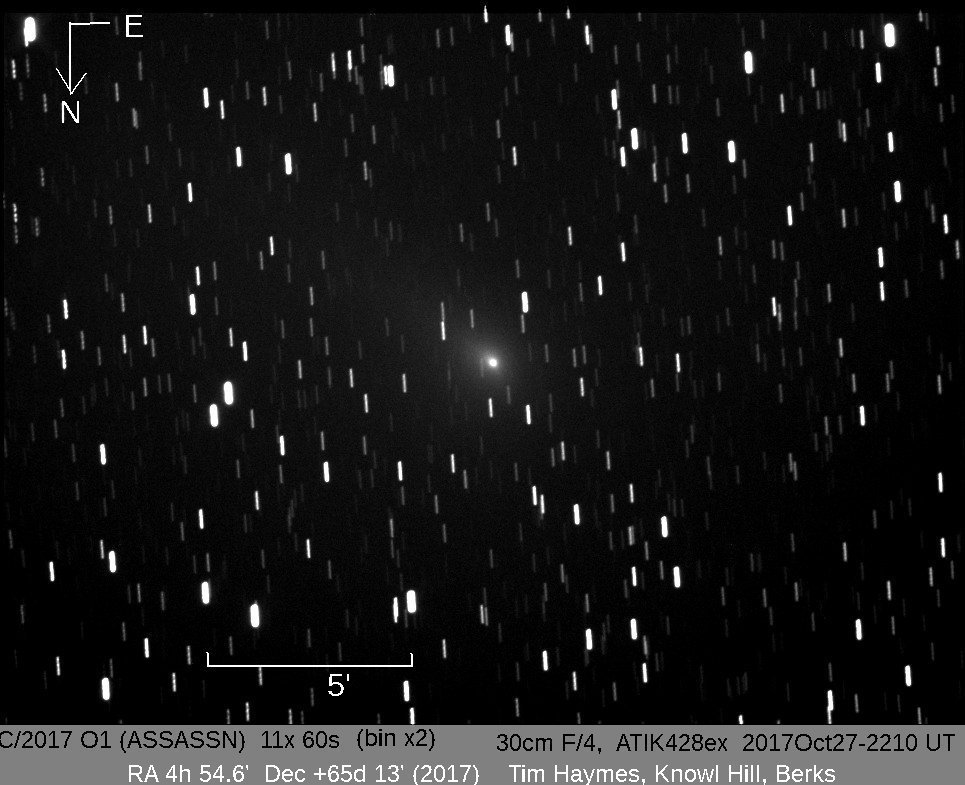
|
| 2017 Oct 5 |
Triton Occults a v12.7
star OBSERVED
|
After much prior testing and planning, a x2 Barlow and W25
filter were used to image the event with WAT-910HX video camera.
Integration time was 0.64s. The recording was to the HD (A2D
dongle) using OccuRec software in AAV format. The fades were
about 6-10s and the duration about 142 sec. |
|
| 2017 Sep 24 |
(31) Euphrosyne - Second
asteroid POSITIVE this year |
After a number of high-profile (bright stars) were clouded
out recently, this prediction for a 0.3 mag drop was successfully
recorded in good conditions. The smallest light drop in some
time, is shows that the video limit is about 0.2 to 0.3 magnitude,
providing the duration is long enough. This was 7.4 sec. and
a 0.25 width path shift is suspected towards the NW. More on
the asteroids page. |
|
| 2017 Aug 30 |
(3122) Florence fly
-by |
Asteroid (3122) Florence - size 7km. passed the other side
of the Moon in this NEO approach to Earth. Aracebo radio telescope
discovered two moons and one appeared to be a contact doublet.
The image wa about an hour in length with images taken 1 min
apart |
|
| 2017 July 21 |
Triton by integrating
video |
While planning for the Triton/stellar Occultation on Oct
5th 2343-2353 UT, I captured some video with WAT-910HX at 0.64s
integrated frames. Triton is there at Mag 13.5. The occulted
star will be Mag 12.3, so the occultation should be detectable.
I used a 5x Teleview Powermate to give 6m focal length. See
"Next Event" menu for more info. |
|
| 2017 Feb 07 |
(690) Wratislavia POSITIVE
1st of 2017
|
Asteroid (690) produced an 8.4s occultation. The D-R was
gradual and small depth of 0.7 magnitude in poor visibility. |
|
| 2016-Dec 03 |
Quasar in outbursts
(CTA102) |
CTA 102 about 5 mage brighter at 12. 30cm F/4 and DSLR. 10x50s
stack |
|
| 2016-Oct 26 |
Holiday in dark skies |
Mortimer SQM 21.4 [The Isles of Silly are darker at 21.6].
Took a tripod and modified 20D. Its dark. Here is Au riga, Perseus
and M45. California Neb at center - 50mm f2.8 lens.
|
|
2016-May 9
|
Mercury Transit |
Canon 70-300 L lens and Milar filter. One of a long series
taken at 1456UT, 1/800th sec, F/11, ISO-100. Hand held. |
|
| 2016-Feb 16 |
(423) Diotima : Long
POSITIVE |
Diotima was at low elevation in Gemini near theta in the
NW. The asteroid was monitored in frosty conditions (-2.5C)
as it occulted a faint star at 4am. I was rewarded by a 29sec
dimming as can be seen in the blue line. |
|
| 2016-Jan 19 |
Lunar Occultation of
Hyades Cluster |
Two step events and one fade were captured by video at 50
fps. These were my first records of instantaneous events during
an occultation by the Moon. The light curve is from 70 Tau by
analysis of the AVI with Limovie. The step duration was 400ms
for near equal components separated by 0.1 sec arc. |
|
| 2015-Sept 30 |
(275) Sapientia POSITIVE |
14 observations from the UK campaign. This is just the RAW
data plot
|
|
| 2015-Sept 28 |
Lunar Eclipse and Umbral graze occultation |
 Traveled South to observe a Lunar Graze Occultation during the
umbral phase of this eclipse. Four events were timed by video.
Traveled South to observe a Lunar Graze Occultation during the
umbral phase of this eclipse. Four events were timed by video.
|
|
| 2015-Sep 20 |
Isles Of Scilly (Tresco) |
Exceedingly dark at SQM 21.6 (measuring starlight). So dark
that this standard Canon 70D was picking up H-alpha in 20s at
F3.5, ISO 25600 |
|
| 2015-Sep 10 |
GRB Optical counterpart |
TA alert: This is a 30min total exposure with ATIK 314L. Recorded
at limit of +20, but not possible to measure (other than position) |
|
| 2015-Sept 04 |
Robin Oldman's 60Da
-Test |
This 60Da was tested between clouds.Works fine for daylight
and astro.
18mm F3.5 from Knowl Hill. Not quite as sensitive as a fully modified
camera, but is good enough and no extra filters needed.
|
|
| 2015 July-Aug |
Asteroids Observed |
Six Negative results reported. The tally for 2015 is currently
a PB of 31 |
|
| 2015 May 18 |
Eruptive object in NGC2770 |
Classified as a SN Imposter, there have been several SNe in
this object over the last few years notably 2007uy and 2008D,
which were shining at the same time. |
|
| 2015 April 22-24 |
Lunar Occultations |
Crescent Moon, 18 events in two evenings timed by video. DD
of ZC858 is indicated in the image. A red M type star and bright
on CCD . |
|
| 2015 April-May |
Galaxy Imaging |
Leo, Virgo and Coma etc. Discovered some interacting groups
inc.the pairing NGC 5258, and the "Guitar" galaxy NGC3561
=> |
|
| 2015 Jan to March |
Asteroid Occultations |
15 events monitored - all reported as negative. The light curve(right)
is of (3) Juno trans-atlantic event.
A 3-sigma shift to the South is indicated on Occult Watcher. There
have no positive sightings to date. |
|
| 2015 Jan 15 |
Comet LoveJoy imaged
magnitude abt 4.5 (10x50bs) but not naked eye.
SQM 19.8 |
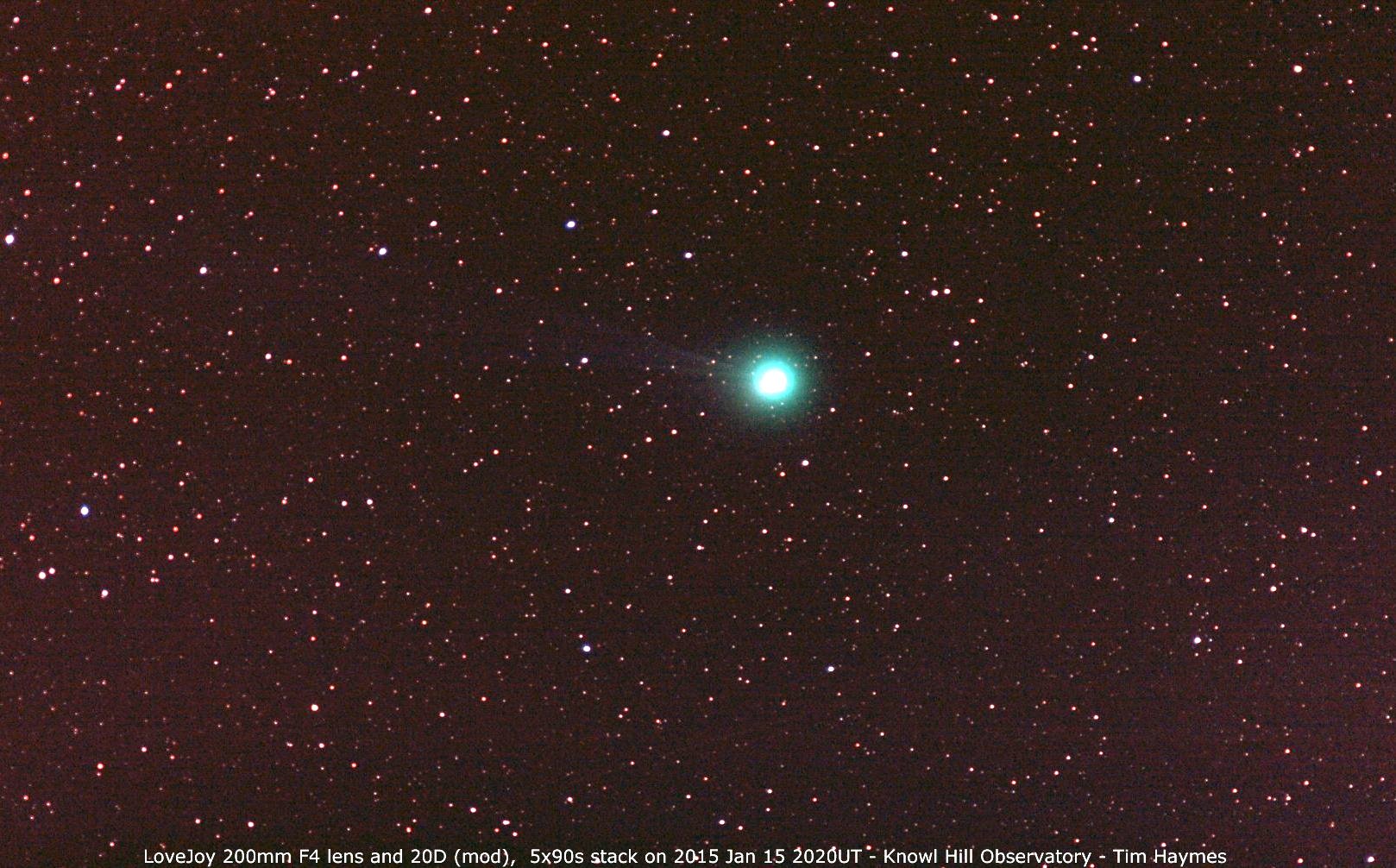
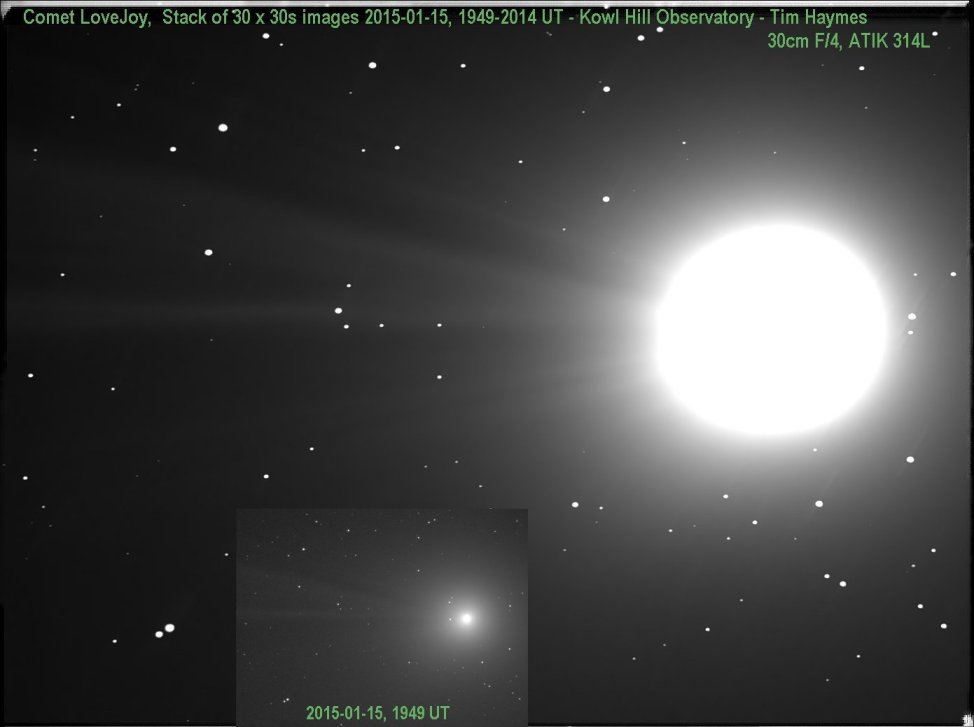

|
DSLR stack 200mm F/4 lens and 30cm F/4 Newt.and ATIK 30x30s
stack |
| 2015 Jan 12 |
(94) Aurora 04h |
This favourable event crossing Scotland - clouded. Most of EU
clouded too. |
- |
| 2015 Jan 10 |
Comet LoveJoy at 2000hrs |
Estimated magnitude at 4.6 based on two stars: viz Nu Tau
and 40 Tau
Diameter of the coma 12 min arc in 10x50Bs. Nice comet but not
Naked eye. Faint tail 0.3d at 10-o-clock detected in images.
|
|
| Dec 29th |
(1010) Marlene |
Second "in-track" event this night was also a MISS.
Cold conditions (-4C). Steve operated the observatory and made
recordings while I was away. |
|
| Dec 29th |
(133) Cyrene |
From inside the predicted track, but was a MISS. Asteroid
detected before mid event time. _Frame.jpg) |
|
2014 Dec 5
2245 UT |
(4513) Louvre occults
4UC 506-0189844
(in Strong Moonlight)
|
NEGATIVE - Cold and clear, this 12.6mag star was monitored at
4/50s integration using WAT910HX _TANGRA_LC.jpg)
_TANGRA_MISS.jpg) Report:
Report: _Report.jpg)
|
|
| 2014 Nov 24 and 29 |
DSLR Imaging |
20D (Mod) 50mm EF at F/4 (1600iso) CLS-CCD, 5 x 2m stack

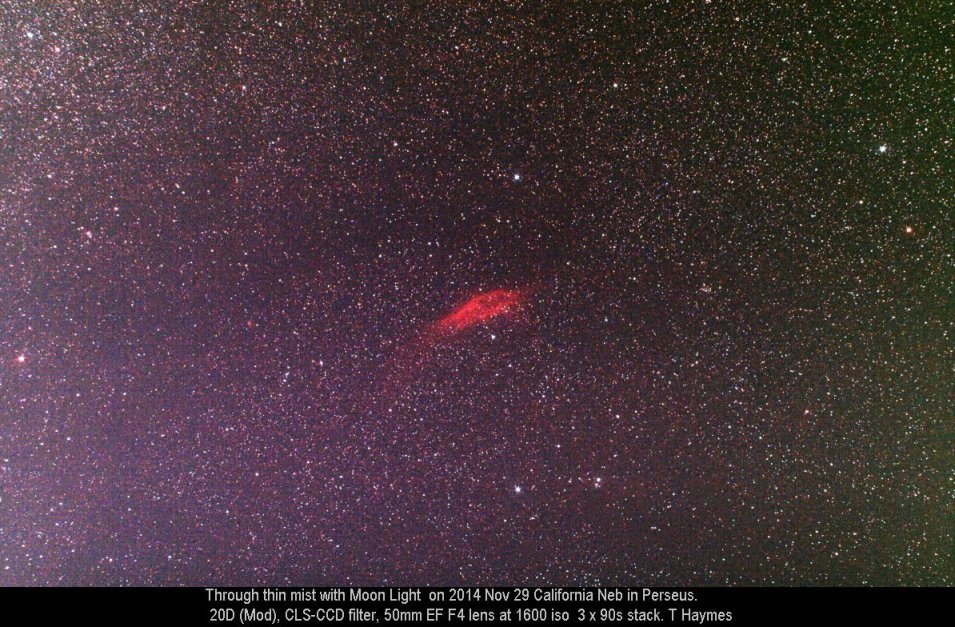
|
|
| 2014 Nov 23 |
(294) Felicia occults
UCAC2 37873176 |
NEGATIVE. Site in the 2-sigma zone 
Darkest night for 4 years ? SQM
20.35 |
|
| 2014 Nov 05 |
PSN J17143829+4340518 |
Suspect Super Nova *Ron Arbour* in an unnamed galaxy near NGC6329 |
|
| 2014 Nov 03 |
(744) Barcelona and
4UCAC 744043860 |
14 km asteroid Barcelona predicted to occult an r13.9 star
dM 0.8, Max Dur 3.4s NEGATIVE in good conditions |
|
2014 Oct 25 |
Lunar Occ of Saturn (daylight) |
The event was clouded, but an attempt was made at 1600UT ( 1700
BST) to see it through breaking clouds using a 10x50 finder. Not
seen. |
- |
| 2014 Oct 24 |
(186) Celuta |
Two events in good clear condition on night 24/25. (154024)
and (186)Celuta both-ve. 13th Mag Celuta was followed for 35min
and video frames extracted. See pic
|
|
| 2014 Oct 22 |
(51324) / 4Cnc at 0004UT |
Two events monitored. The first was obstructed, the second
involved the star 4 Cnc which was recorded through tree branches
- No occultation. Clear sky (SQM 20.1) after storms.
|
|
| 2014 Oct 18 |
(476) Hedwig long duration |
Cloud prevented this 60s event (max) being monitored. A brief
clearing 45 min before allowed set up, and the field was videoed
before cloud returned.
|
|
| 2014 Oct 12 |
Sony DVcam
TRV33E doesnt display video-in ? |
In the VCR-OTHERS menu, set DISPLAY = LCD. Now it does. |
- |
| 2014 Sep 25 |
(396) Padua /TYC 1293-00396-1 |
Got a miss with this bright (r 9.7) star. I was 160km North.
J.M Winkel (NL) recorded a Positive indicated a South shift. |
|
| 2014 Sep 22 |
(89) Julia / UCAC4 568_045000 |
Small magnitude drop 11.8 > 12.0. Asteroid visible rising
out of trees. Alt 20, Az 077
Reported as uncertain. See Blue curve: .jpg)
|
|
| 2014 Sep 18 |
(2060) Chiron Occultation |
Star was 1 mag fainter than predicted making it difficult,
and it was also cloudy. Here is a 2.5 sec test exposure 30cm F/4,
WAT-910HX |
|
| 2014 Sep 12 |
Galaxy Imaging. |
Polar-aligned the EQ6 for better GOTO. All images except the
first were out of focus! The camera seems to have moved a bit.
Firework Gal=>
|
|
| 2014 Sep 10 |
Limiting Magnitude (Moon rising) |
M57 was videoed with 30cm F/4 and WAT910HX and found Mag 16
was reached in 1.28 sec (64/50sec, gain 32 dB)
|
|
| 2014 Sep 06 to 9th |
Asteroid Occs clouded out !
|
Dido, Algeria, Celuta, Kuopio and Alauda - no observations |
- |
2014 Sep 02
|
(391) Ingerborg |
Adrian Jones (Maidenhead) successfully recorded a 2.2s event
while I was at ESOP XXXIII in Prague. He used my video cam.
on his 190mm Mak-Newt. What a great result for him, and an example
of local collaboration. |
|
2014Aug24
0134UT |
(291) Alice |
No occultation in very clear sky SQM 20.2. Report: 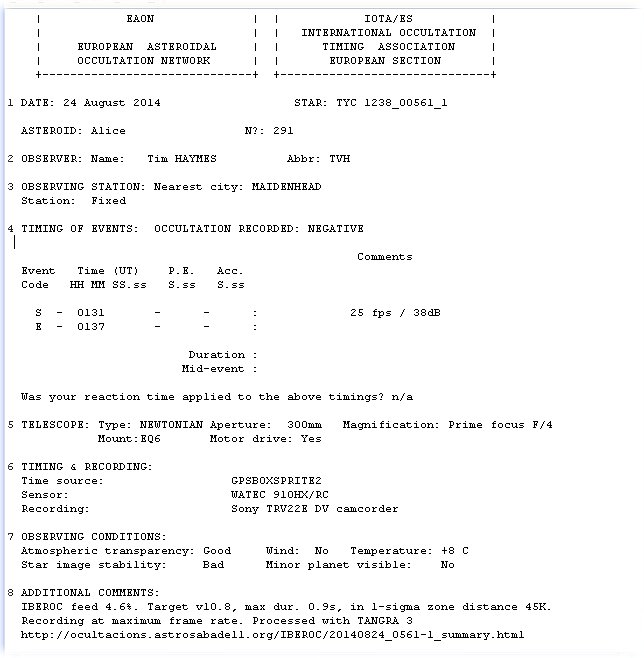 |
|
| 2014Aug23 |
C/2014 E2 Jacques |
A 7x2min stack with 20D (800iso) and 200mm
F2.8 L lens from LensesForHire.
Exceedingly stretched to bring out the faint narrow tail at
about 5-o'-clock |
|
| 2014Aug20 |
C/2014 E2 Jacques |
In Cassiopeia near IC1805, 20D(mod), Canon 50mm f2.5  |
|
2014Aug13
|
Perseid watch 2230 - 0045BST |
Logged 2, imaged 1 (Limit 4.0) Moon rising. Clear sky with patchy
cloud, thick at times. A bit disappointing, although 24hr after
max. |
|
| 2014Aug05 2100 UT |
WINGS 2014 SPACE Sub-camp |
Helped at Windsor InterNational Guide and Scout camp with my
Meade SN8, and members of Maidenhead and Reading Astro Socs. |
|
2014Aug03
0100 UT |
Galaxies in Hercules imaged with Meade DSI2.
NGC6371 is selected. |
A nice imaging session. I like the way Envisage does on-the-fly
track and stack. A good dark frame and stable external temp works
well. Tweeked in AA5 |
|
| 2014Aug02 2300 UT |
Master OT with ATIK 314L |
The ATIK driver stops the EQMOD driver!
CLOSE EQMOD, and restart - seems OK now. Optical Transient too
faint and low elevation. |
|
| 2014Jul06 |
Lunar Occultation (DD) of SAO158236 |
21h 46m 04.52 using WAT-910HX and GPSBOXSPRITE2
|
|
| 2014May25 |
Ceres and Vesta |
Images with 20D and 200mm lens - sequence at 5 min intervals
|
|
| 2014May17 |
PANSTARRS at 2300 hrs |
Imaged with 30cm F/4, Canon 20D, DeepSky Stacker.
|
|
| 2014Apr17 |
(386)
Siegena 14 sec
occultation |
Morning observation in strong twilight (Sun-7). Long event
revealed by photometry with TANGRA.
|
- |
| - |
- |
- |
- |
| 2014Mar20 |
Ergone Occults Regulus -VE.
Flew to Bermuda for a family holiday.
David Dunham joined us at last minute with his MAXI. Cloud stopped
my obs.
|
|
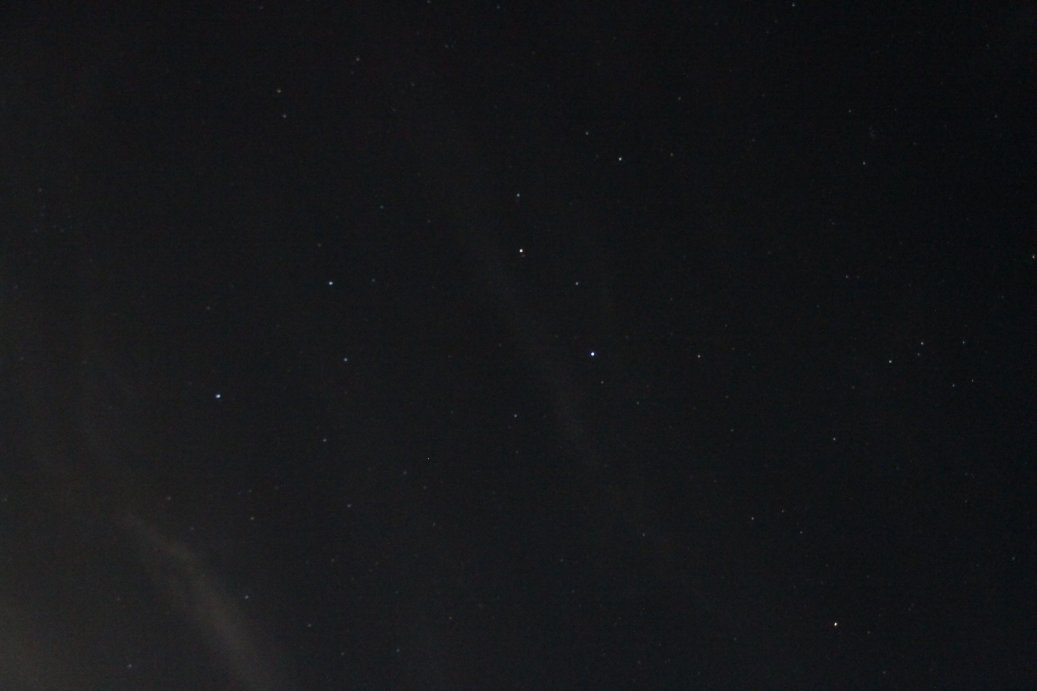 2Hrs before cloud arrived
2Hrs before cloud arrived |
| 2014Mar03 |
Aurora from Norway, 2 nights out of 5. |
.jpg)

.jpg)
.jpg) .jpg) |
|
| 2014Jan23 |
SN 2014J in M82 |
Meade DSI-1 LRGB and monochrome imaging with photometry. |
|
| 2014Jan17 |
Short (1.2 sec) event
for (56) Melete. |
First asteroid occultation positive since over a years ago (none
seen in 2013). This is a good start to the year. TANGRA photometry
found it. |
- |
1970 Nov 28 |
Purchase of an AE 6" F/8 mirror |
Peter Lancaster-Brown recommended Astronomical Equipments
(AE) Luton. A 1/10 wave mirror and flat were purchase for £
17-12-6p. The optics were used in wooden square lattice tube on
a alt-az mounting. Eyepieces were from Fullerscopes: Opposite:
Eclipse 1973 with the 6" on the fore-deck of the good ship
Monte Umbe. (Trans-solar-travell) |
|